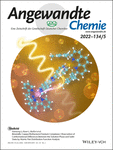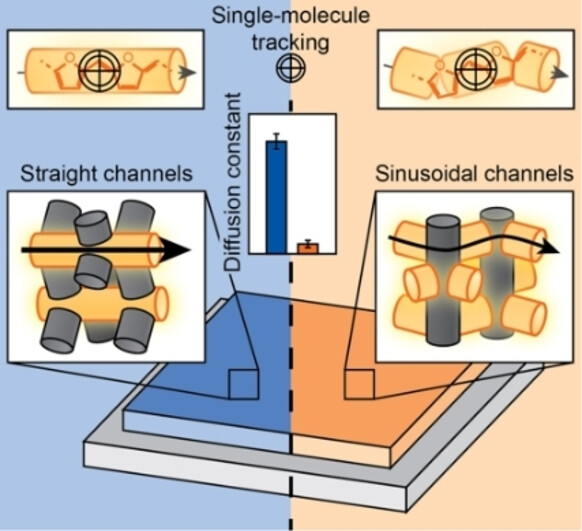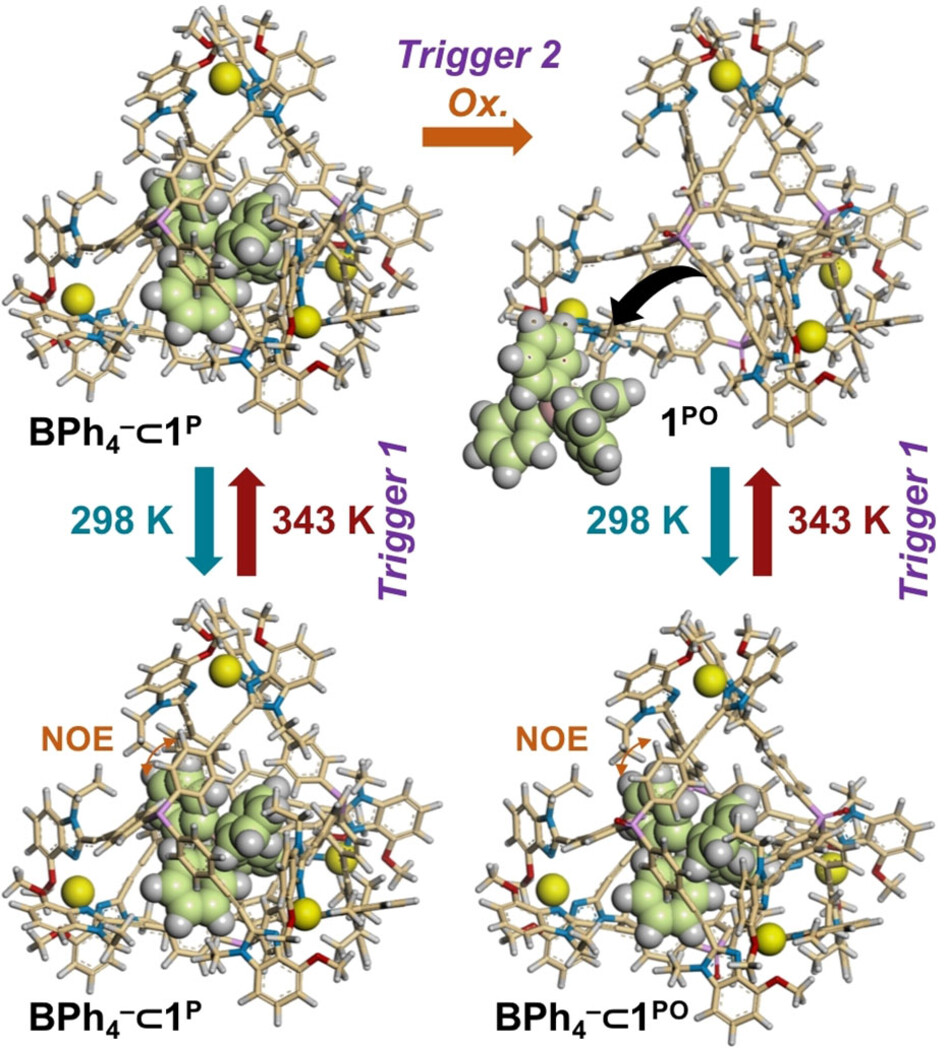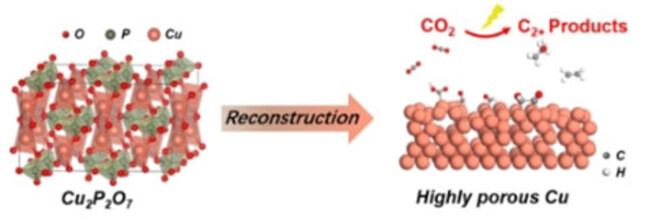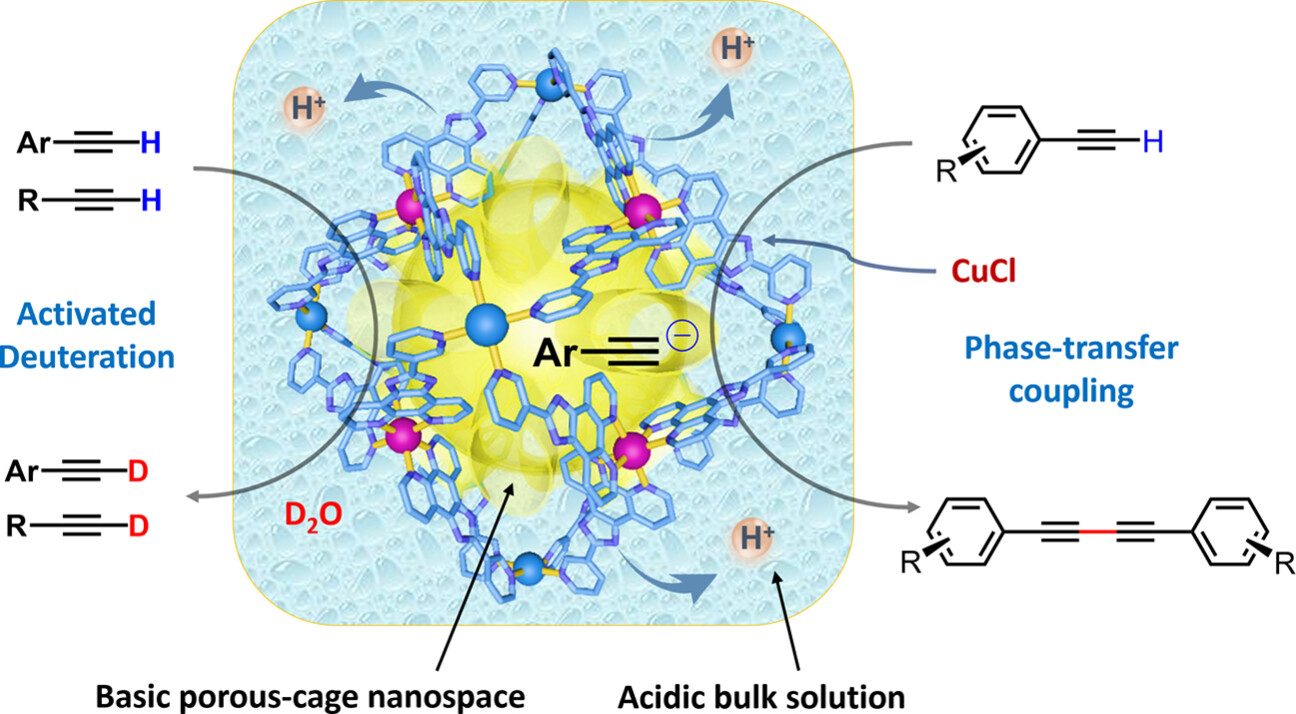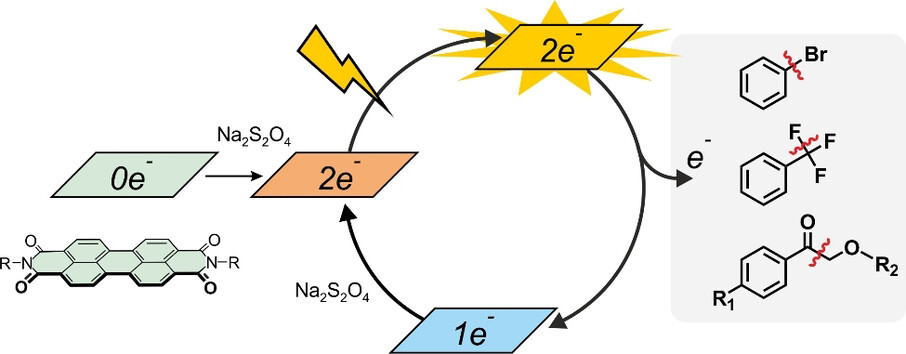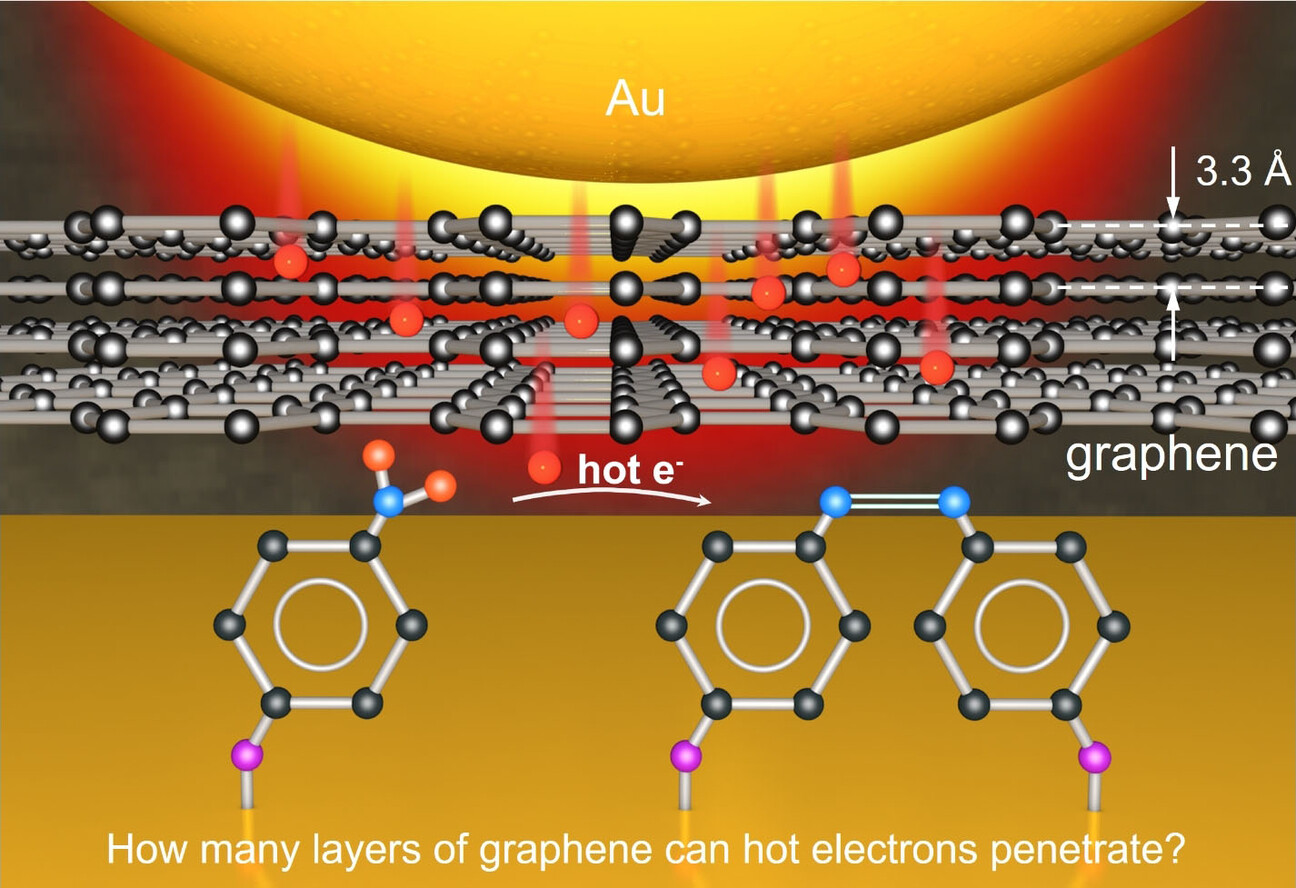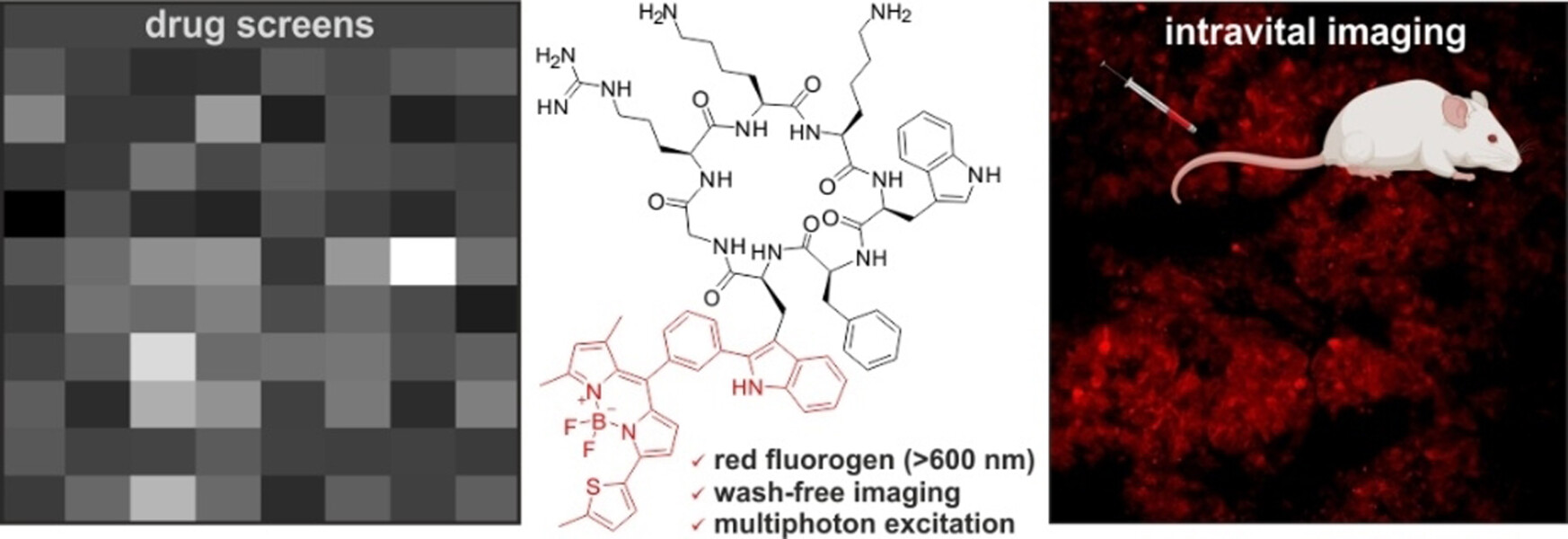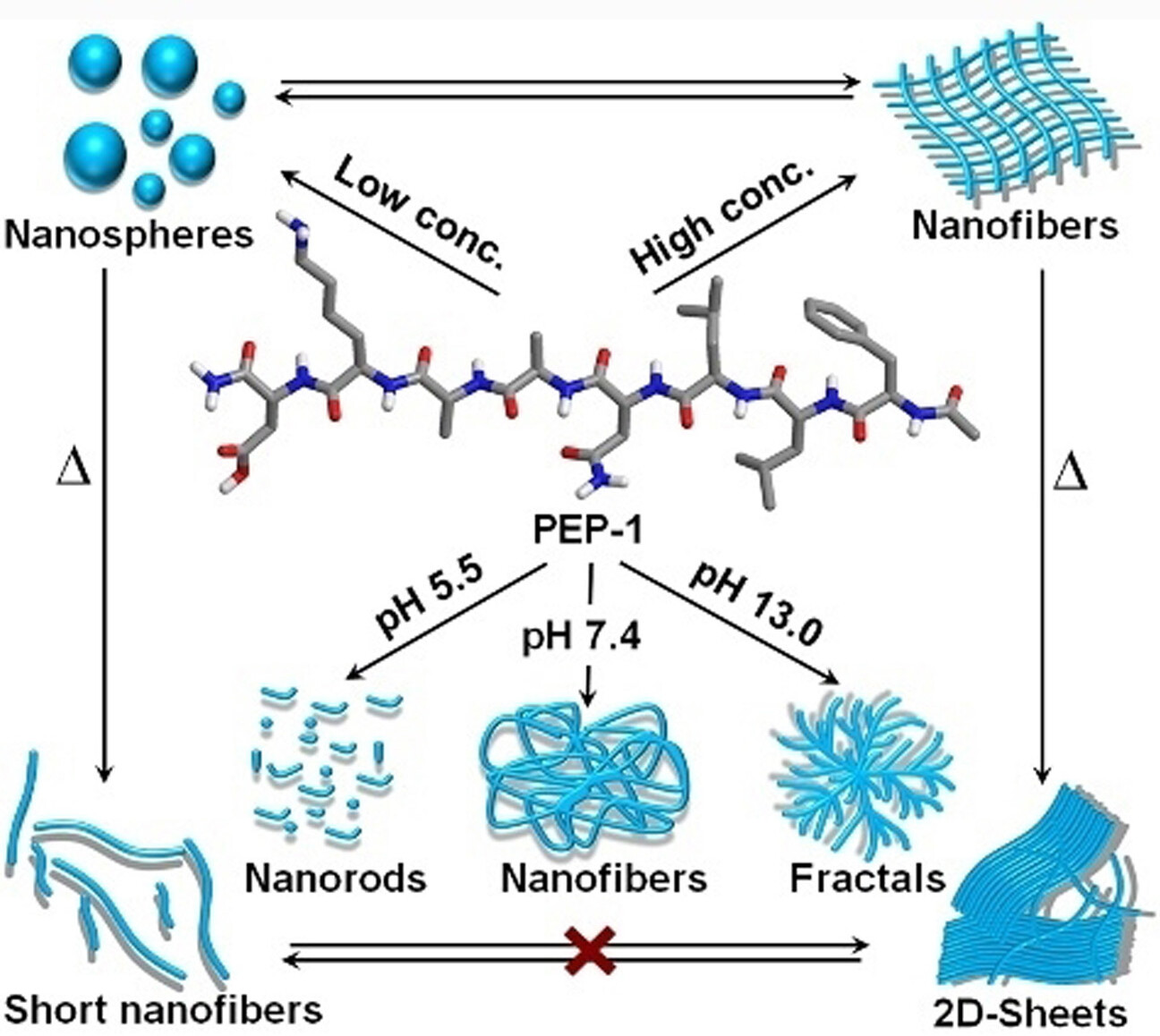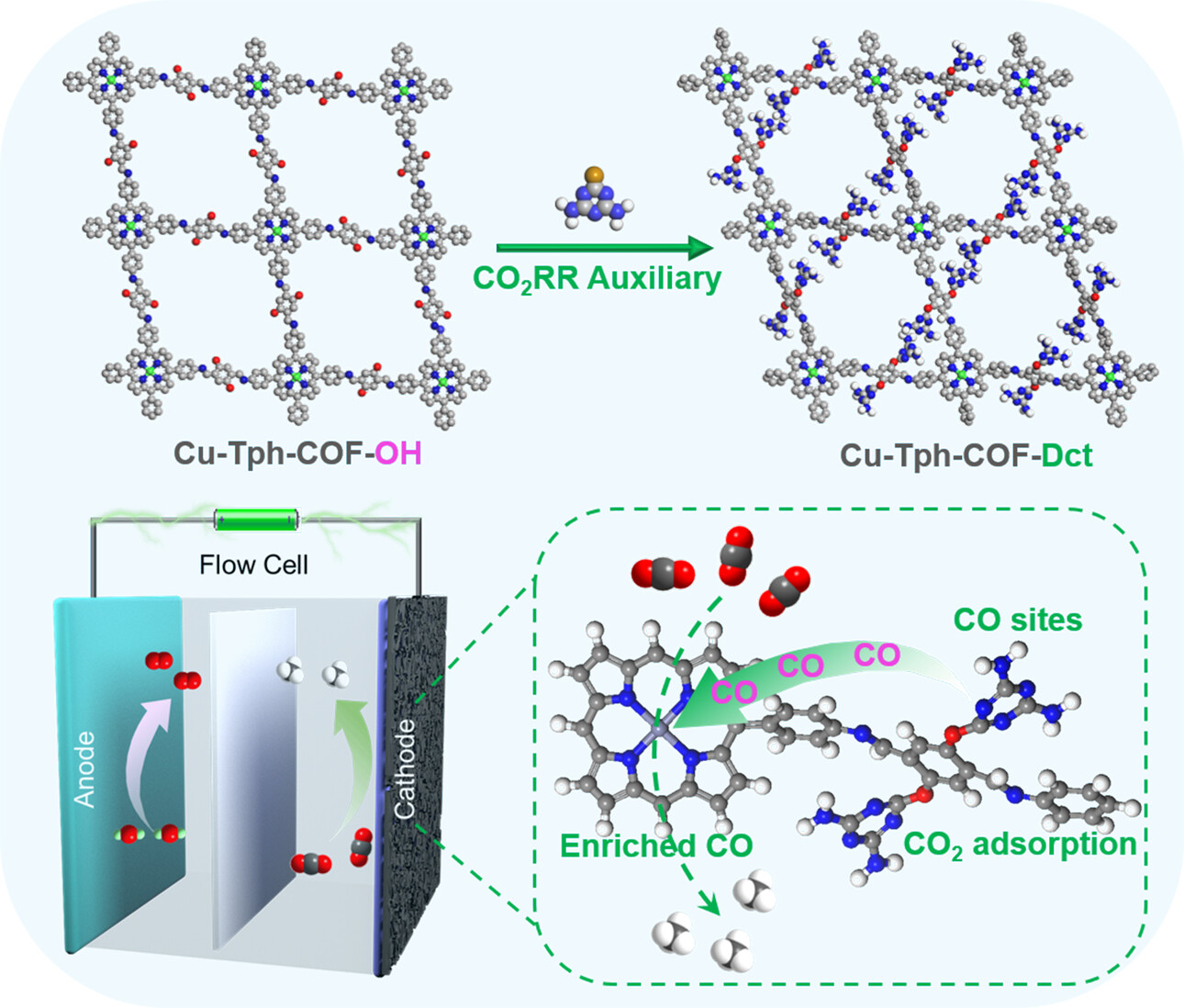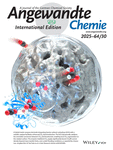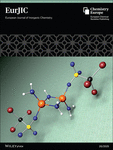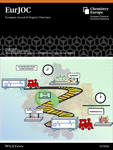Journal list menu
Export Citations
Download PDFs
Titelbild
Titelbild: Bimetallic Copper/Ruthenium/Osmium Complexes: Observation of Conformational Differences Between the Solution Phase and Solid State by Atomic Pair Distribution Function Analysis (Angew. Chem. 5/2022)
- First Published: 20 December 2021
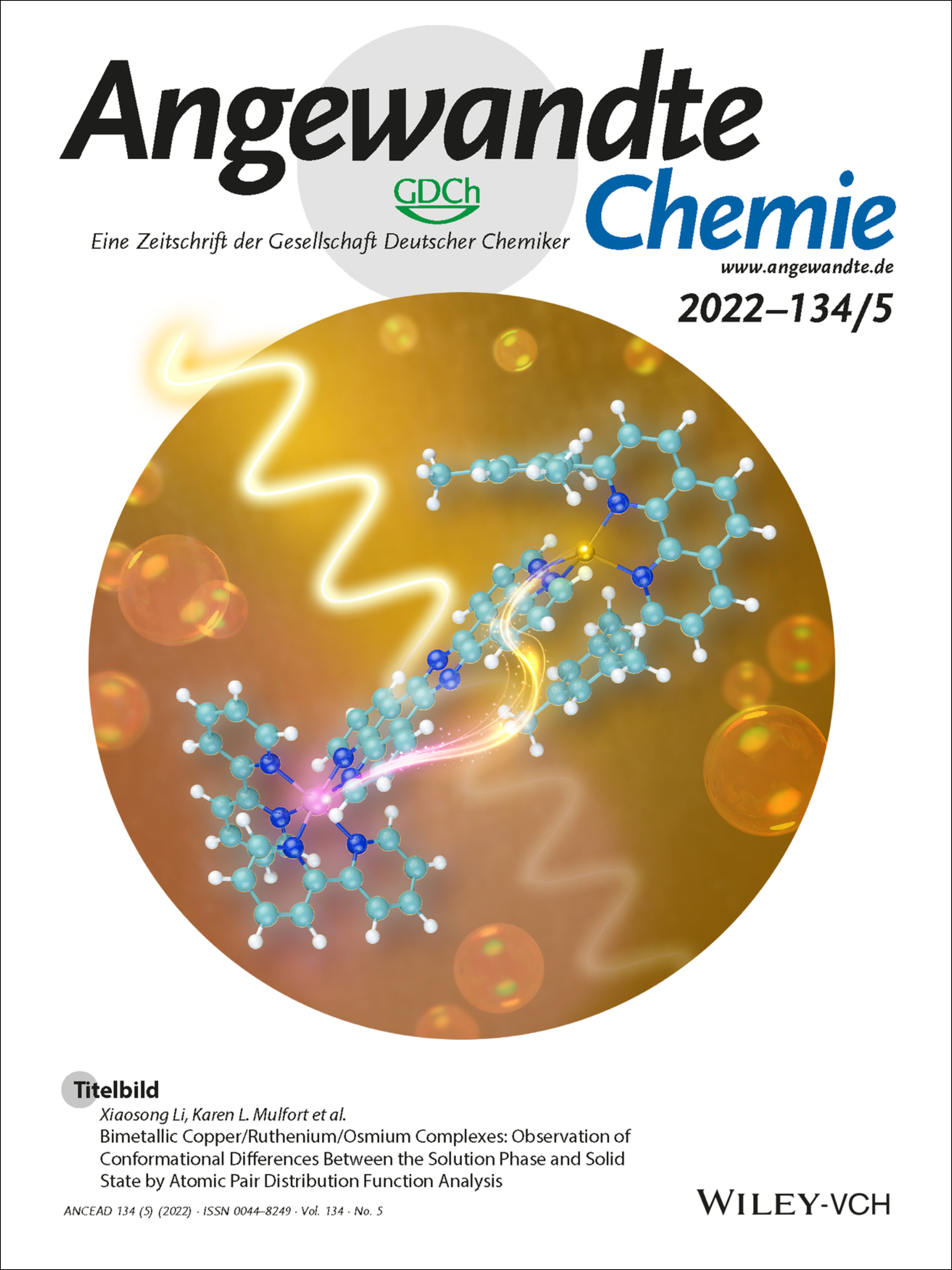
Die Molekülstrukturen von fünf redox- und photoaktiven Bimetallkomplexen in der Lösungsphase wurden im Forschungsartikel von Xiaosong Li, Karen L. Mulfort und Mitarbeitern mittels Hochenergie-Röntgenstreuung und paarweiser Atomverteilungsfunktion aufgedeckt (e202111764). Die Analyse zeigt signifikante Konformationsunterschiede zwischen der Lösungsphase und den Festkörperstrukturen dieser Komplexe, die für die Wechselwirkungen zwischen den beiden Metallzentren relevant sein könnten.
Innentitelbild: Stable Isotope Phosphate Labelling of Diverse Metabolites is Enabled by a Family of 18O-Phosphoramidites (Angew. Chem. 5/2022)
- First Published: 10 January 2022
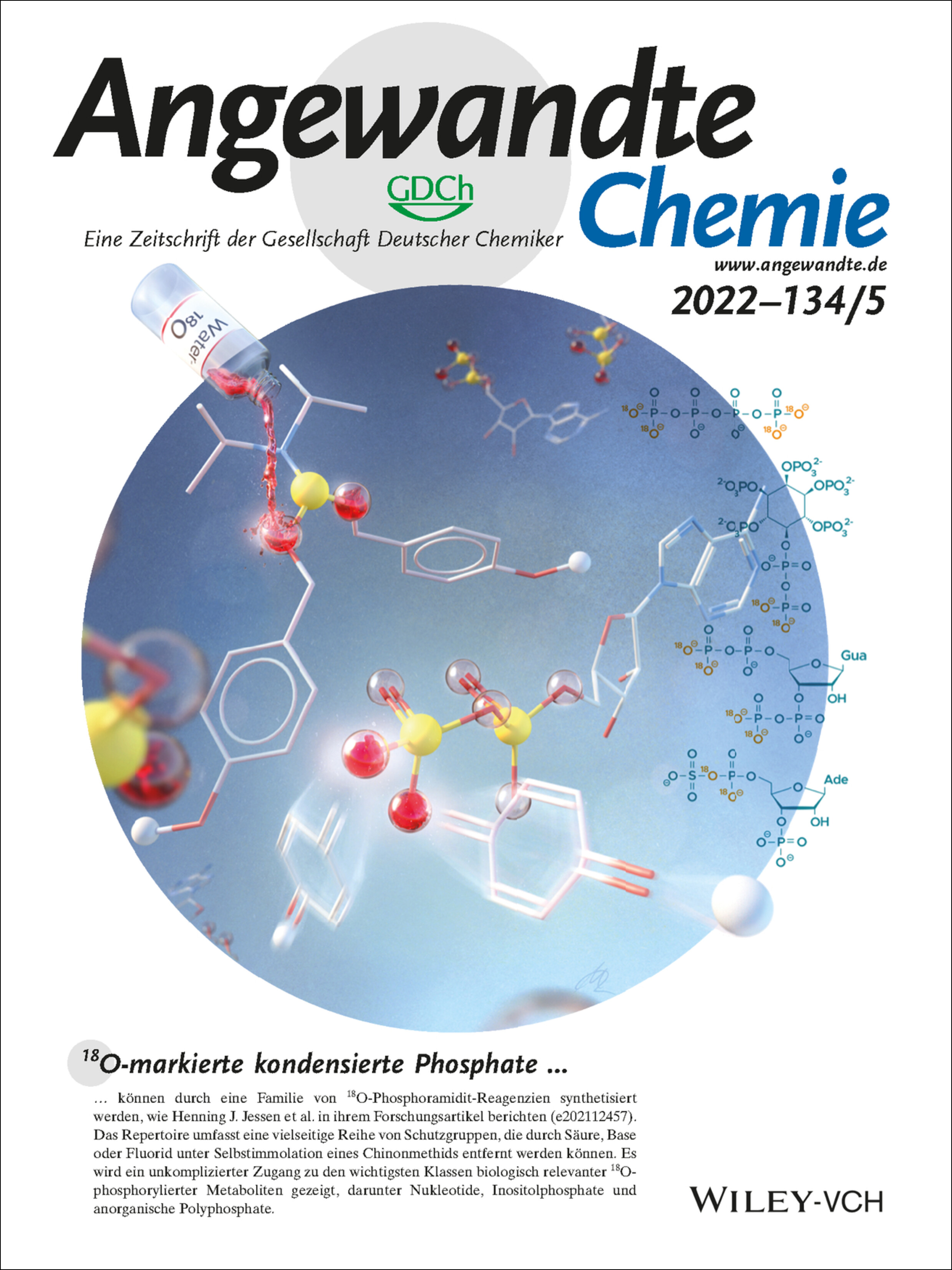
18O-markierte kondensierte Phosphate können durch eine Familie von 18O-Phosphoramidit-Reagenzien synthetisiert werden, wie Henning J. Jessen et al. in ihrem Forschungsartikel berichten (e202112457). Das Repertoire umfasst eine vielseitige Reihe von Schutzgruppen, die durch Säure, Base oder Fluorid unter Selbstimmolation eines Chinonmethids entfernt werden können. Es wird ein unkomplizierter Zugang zu den wichtigsten Klassen biologisch relevanter 18O-phosphorylierter Metaboliten gezeigt, darunter Nukleotide, Inositolphosphate und anorganische Polyphosphate.
Innenrücktitelbild: Generation of Oxyphosphonium Ions by Photoredox/Cobaloxime Catalysis for Scalable Amide and Peptide Synthesis in Batch and Continuous-Flow (Angew. Chem. 5/2022)
- First Published: 20 December 2021
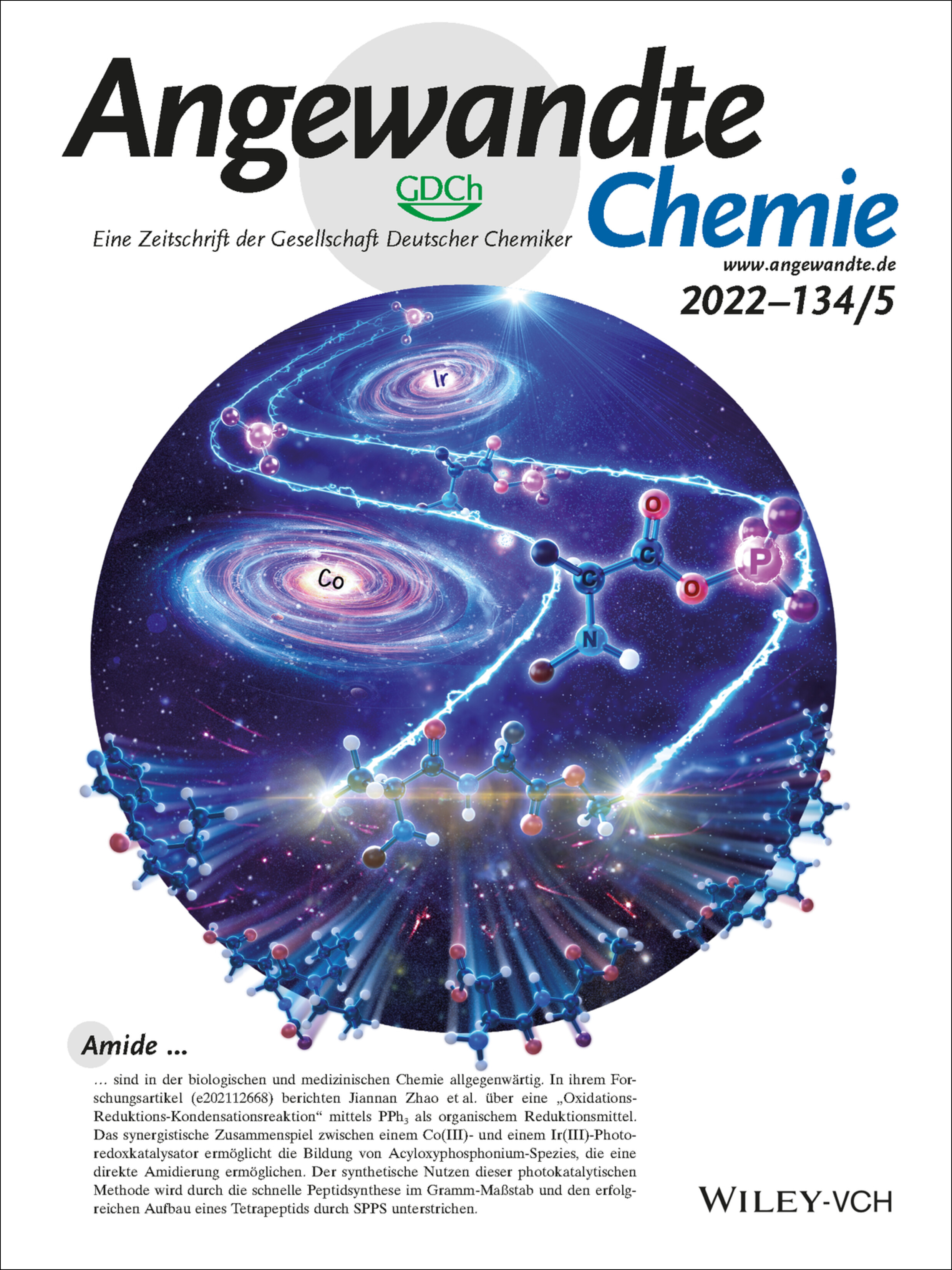
Amide sind in der biologischen und medizinischen Chemie allgegenwärtig. In ihrem Forschungsartikel (e202112668) berichten Jiannan Zhao et al. über eine “Oxidations-Reduktions-Kondensationsreaktion” mittels PPh3 als organischem Reduktionsmittel. Das synergistische Zusammenspiel zwischen einem Co(III)- und einem Ir(III)-Photoredoxkatalysator ermöglicht die Bildung von Acyloxyphosphonium-Spezies, die eine direkte Amidierung ermöglichen. Der synthetische Nutzen dieser photokatalytischen Methode wird durch die schnelle Peptidsynthese im Gramm-Maßstab und den erfolgreichen Aufbau eines Tetrapeptids durch SPPS unterstrichen.
Rücktitelbild: Unravelling Channel Structure–Diffusivity Relationships in Zeolite ZSM-5 at the Single-Molecule Level (Angew. Chem. 5/2022)
- First Published: 23 December 2021
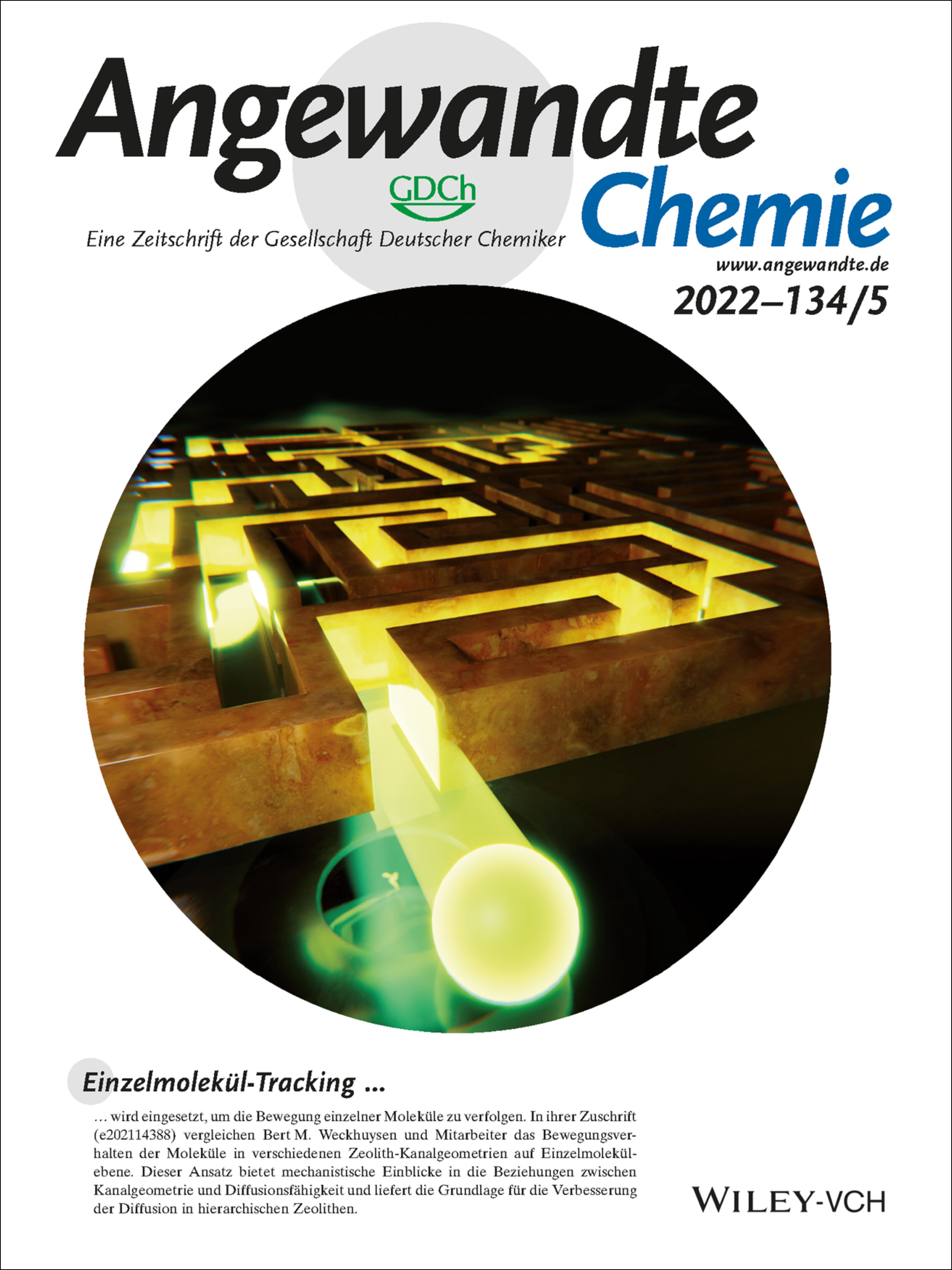
Einzelmolekül-Tracking wird eingesetzt, um die Bewegung einzelner Moleküle zu verfolgen. In ihrer Zuschrift (e202114388) vergleichen Bert M. Weckhuysen und Mitarbeiter das Bewegungsverhalten der Moleküle in verschiedenen Zeolith-Kanalgeometrien auf Einzelmolekülebene. Dieser Ansatz bietet mechanistische Einblicke in die Beziehungen zwischen Kanalgeometrie und Diffusionsfähigkeit und liefert die Grundlage für die Verbesserung der Diffusion in hierarchischen Zeolithen.
Frontispiz
Frontispiz: Aggregation-Enhanced Sonodynamic Activity of Phthalocyanine–Artesunate Conjugates
- First Published: 18 January 2022

Sonosensibilisatoren Mei-Rong Ke, Jian-Dong Huang et al. berichten in ihrer Zuschrift (e202113506) über eine aggregationsverstärkte sonodynamische Aktivität (AESA). Der AESA-Effekt könnte einen neuen Weg für die Entwicklung effizienter Sonosensibilisatoren eröffnen.
Frontispiz: Creating Dynamic Nanospaces in Solution by Cationic Cages as Multirole Catalytic Platform for Unconventional C(sp)−H Activation Beyond Enzyme Mimics
- First Published: 18 January 2022

Supramolekulare Katalyse In ihrem Forschungsartikel (e202114070) berichten Cheng-Yong Su et al. über die Herstellung von dynamischen Nanoräumen mittels hoch geladener kationischer Käfige als katalytische Plattformen für die C(sp)-H-Aktivierung.
Graphisches Inhaltsverzeichnis
Graphisches Inhaltsverzeichnis: Angew. Chem. 5/2022
- First Published: 18 January 2022
Introducing …
Christine Beemelmanns
- First Published: 29 November 2021

“My biggest motivation is to accomplish and create something that makes a difference … My motto is that new findings always pave the way to new intriguing research questions, and that Mother Nature might have already invented it …” Find out more about Christine Beemelmanns in her Introducing … Profile.
Jiannan Zhao
- First Published: 10 December 2021

“I am waiting for the day when someone will discover the origin of homochirality in nature … A key experience in my education was a trip to Germany and attending the 65th Lindau Nobel Laureates Meeting with ambitious young scientists from all natural science disciplines…” Find out more about Jiannan Zhao in his Introducing … Profile.
Tagungsbericht
Organic Chemistry
Plugging the Leak: Empowering Women in Organic Chemistry
- First Published: 20 December 2021
Held June 24–25, 2021, the third annual Empowering Women in Organic Chemistry (EWOC) conference gathered organic chemists at all stages of the career pipeline for rich professional development opportunities and a showcase of recent scientific achievements. This Meeting Review outlines the program.
Kurzaufsätze
Metalle in der Medizin
Klinische Entwicklung von Metallkomplexen als Photosensibilisatoren für die photodynamische Therapie von Krebs
- First Published: 08 November 2021

Die photodynamische Therapie hat die traditionellen Krebsbehandlungsmethoden ergänzt. Trotz ihres Erfolgs sind die klinisch eingesetzten Photosensibilisatoren nicht ideal. Um diese Beschränkungen zu überwinden, werden zunehmend Forschungsbemühungen auf die Einbindung von Metallionen gerichtet. In diesem Kurzaufsatz wird der klinische Status von metallhaltigen Verbindungen als Photosensibilisatoren für die photodynamische Therapie untersucht.
Aufsätze
Homogeneous Catalysis
Metathesis by Partner Interchange in σ-Bond Ligands: Expanding Applications of the σ-CAM Mechanism
- First Published: 25 October 2021

This review highlights advances in the characterization and dynamic rearrangements of σ-bond complexes, most notably alkane and zincane complexes, but also different geometries of silane and borane complexes. We set out a selection of catalytic and stoichiometric examples of the σ-complex assisted metathesis mechanism that are supported by strong experimental and/or computational evidence.
Metal Halide Perovskites
Atomic Level Insights into Metal Halide Perovskite Materials by Scanning Tunneling Microscopy and Spectroscopy
- First Published: 13 October 2021
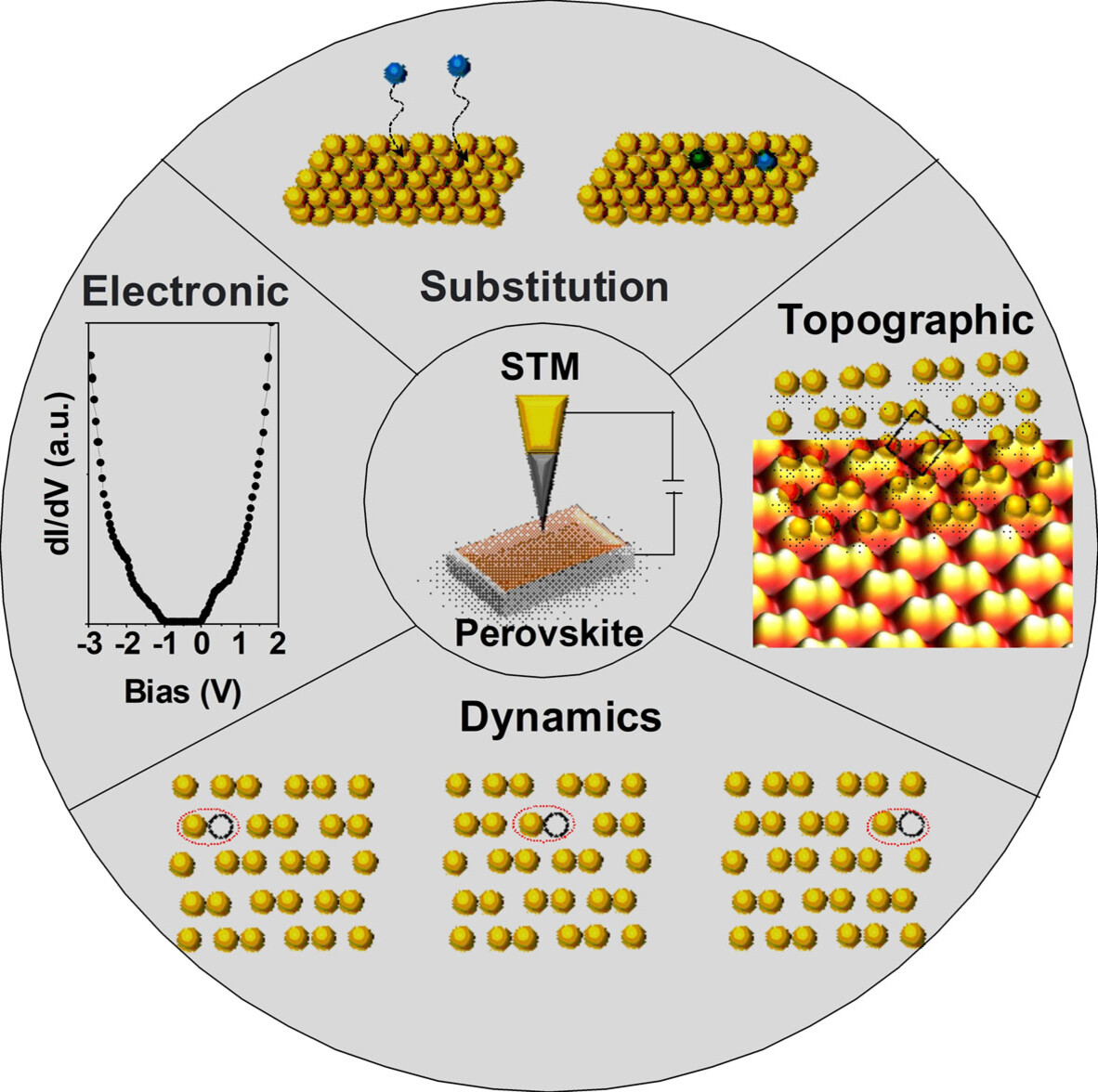
Scanning tunneling microscopy and spectroscopy are powerful techniques to visualize the topographic and electronic structures of metal halide perovskites with atomic-level resolution. These techniques can also be used to reveal the dynamics of surface defects and charge carriers as well as on-surface reactions and optoelectronic properties at the surface and interfaces of perovskite materials.
Zuschriften
Sonodynamic Therapy | Hot Paper
Aggregation-Enhanced Sonodynamic Activity of Phthalocyanine–Artesunate Conjugates
- First Published: 10 November 2021
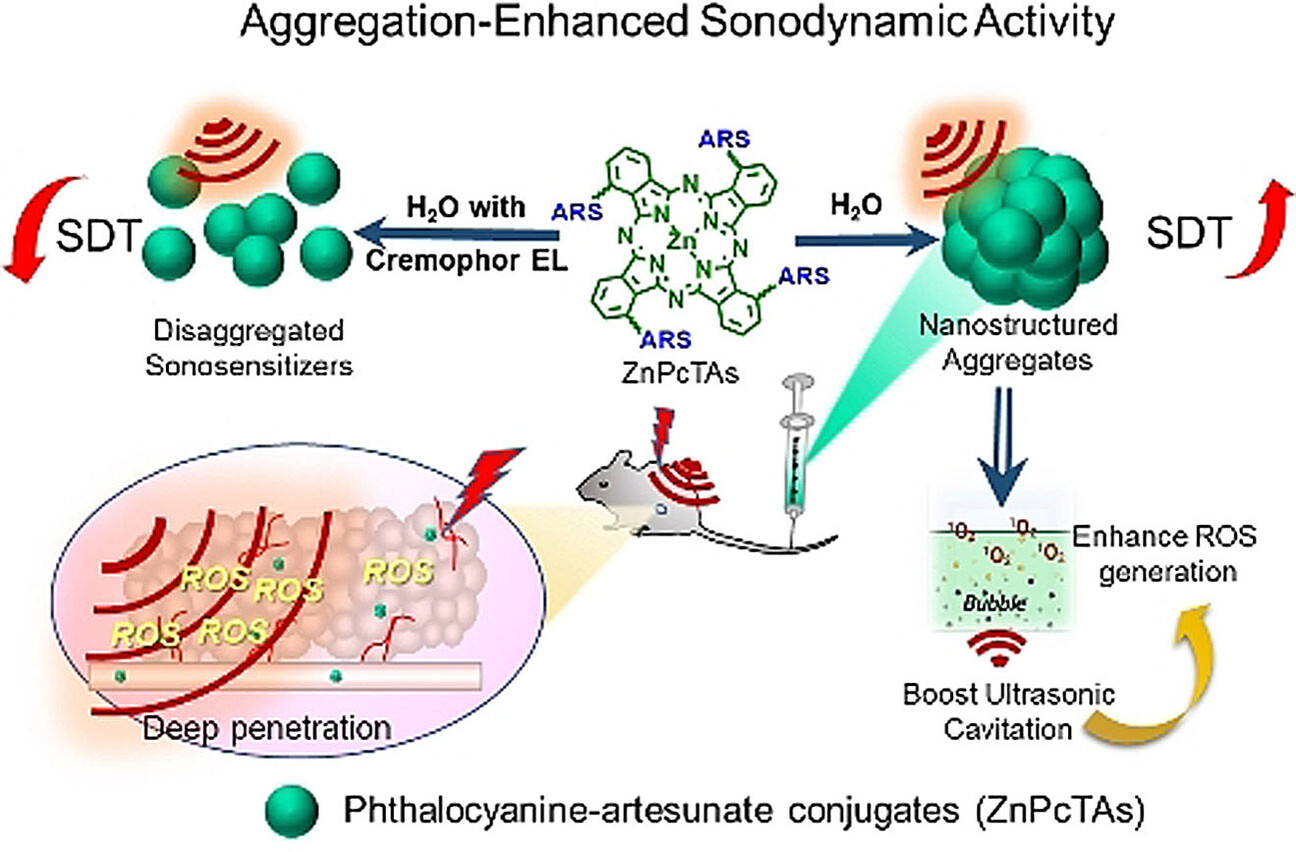
An interesting aggregation-enhanced sonodynamic activity (AESA) effect was first observed based on the studies of phthalocyanine–artesunate conjugates and common organic sonosensitizers, which arose from boosted ultrasonic cavitation caused by nanostructured aggregates. We believed that the AESA effect in this work could open up a new avenue for the development of efficient sonosensitizers.
Zeolites | Very Important Paper
Unravelling Channel Structure–Diffusivity Relationships in Zeolite ZSM-5 at the Single-Molecule Level
- First Published: 17 November 2021
Fluorescent Probes | Hot Paper
Rational Design of a Two-Photon Fluorescent Probe for Human Cytochrome P450 3A and the Visualization of Mechanism-Based Inactivation
- First Published: 01 December 2021

A two-photon fluorescent probe for CYP3A was developed using a rational design strategy that optimized the key binding domain of the fluorophore. The probe semi-quantitatively detects and images CYP3A activity in various living systems, thereby providing a high-throughput screening system facilitating the evaluation of MBI-associated hepatotoxicity by CYP3A.
Supramolecular Chemistry
Entropy Versus Enthalpy Controlled Temperature/Redox Dual-Triggered Cages for Selective Anion Encapsulation and Release
- First Published: 18 November 2021
CO2 Reduction
A Reconstructed Cu2P2O7 Catalyst for Selective CO2 Electroreduction to Multicarbon Products
- First Published: 02 December 2021
Fluorescent Probes | Very Important Paper
A Bright, Renal-Clearable NIR-II Brush Macromolecular Probe with Long Blood Circulation Time for Kidney Disease Bioimaging
- First Published: 30 November 2021
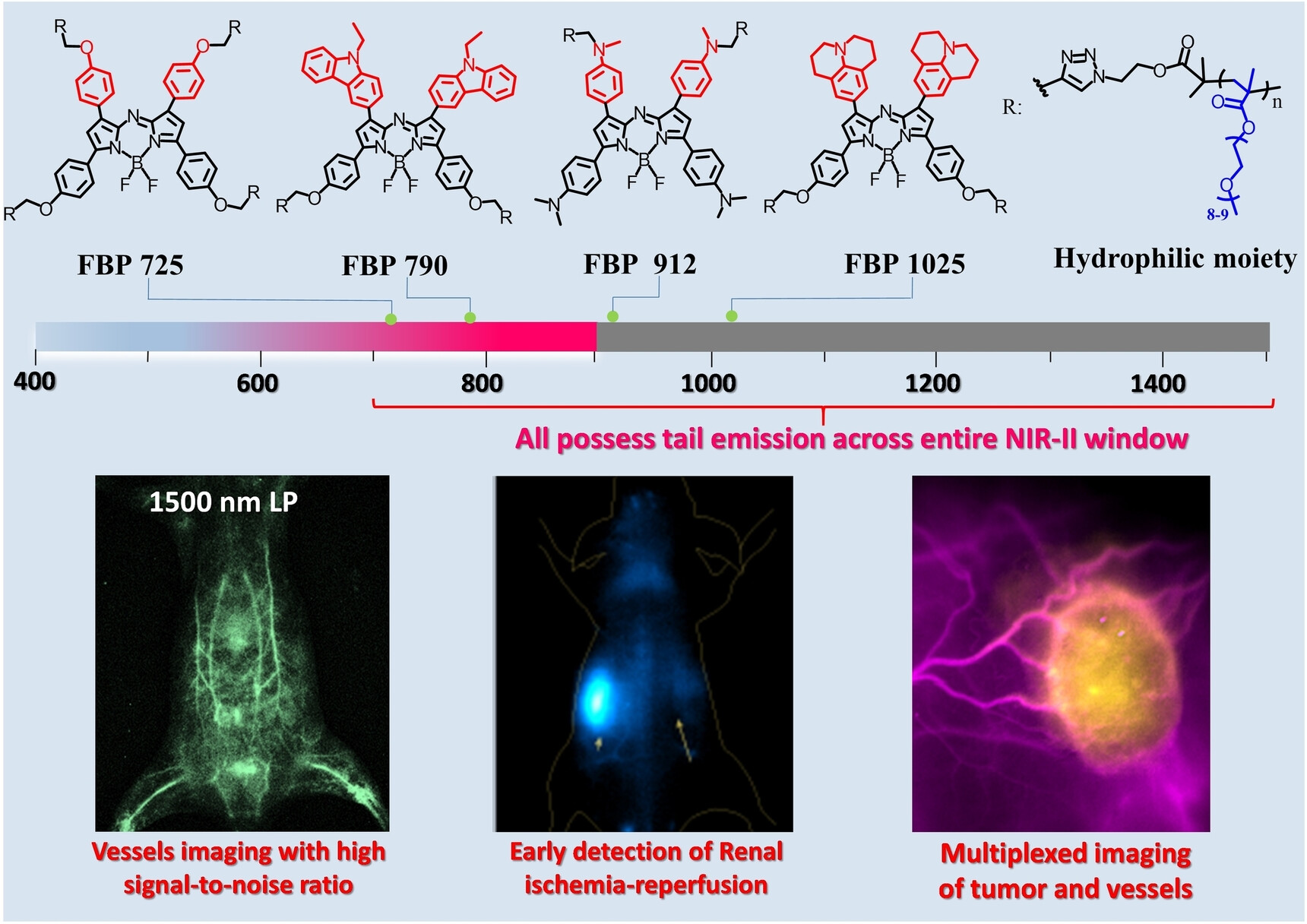
A series of bright NIR-II brush macromolecular fluorophores (FBP) with high renal-clearance efficiency and long-blood circulation time has been developed. These achieve real-time in vivo NIR-II imaging of renal ischemia-reperfusion injury, tumor passive targeted imaging and renal cell carcinoma active targeted imaging with higher signal-to-noise ratio and extended retention time.
Photoacoustic Imaging
Cathespin B-Initiated Cypate Nanoparticle Formation for Tumor Photoacoustic Imaging
- First Published: 08 December 2021

A near-infrared photoacoustic (PA) probe Cypate-CBT was designed for specific imaging and real-time tracking of cathespin B (CTSB) activity in CTSB-overexpressing cells and tumors. After Cypate-CBT entered into CTSB-overexpressing cells, it underwent glutathione reduction and CTSB cleavage to generate cypate nanoparticles Cypate-CBT-NPs, which enhanced both the intensity and retention time of the PA signal in tumor sites.
Medicinal Chemistry
Potent and Selective RIPK1 Inhibitors Targeting Dual-Pockets for the Treatment of Systemic Inflammatory Response Syndrome and Sepsis
- First Published: 01 December 2021

A series of highly potent dual-mode RIPK1 inhibitors occupying both the allosteric and the ATP binding pockets were developed, exemplified by compound 21 (ZB-R-55), which is about 10-fold more potent than GSK2982772, and exhibits excellent kinase selectivity, good oral pharmacokinetics and good therapeutic effects in the LPS-induced sepsis model.
Materials Science | Hot Paper
Orienting an Organic Semiconductor into DNA 3D Arrays by Covalent Bonds
- First Published: 30 November 2021
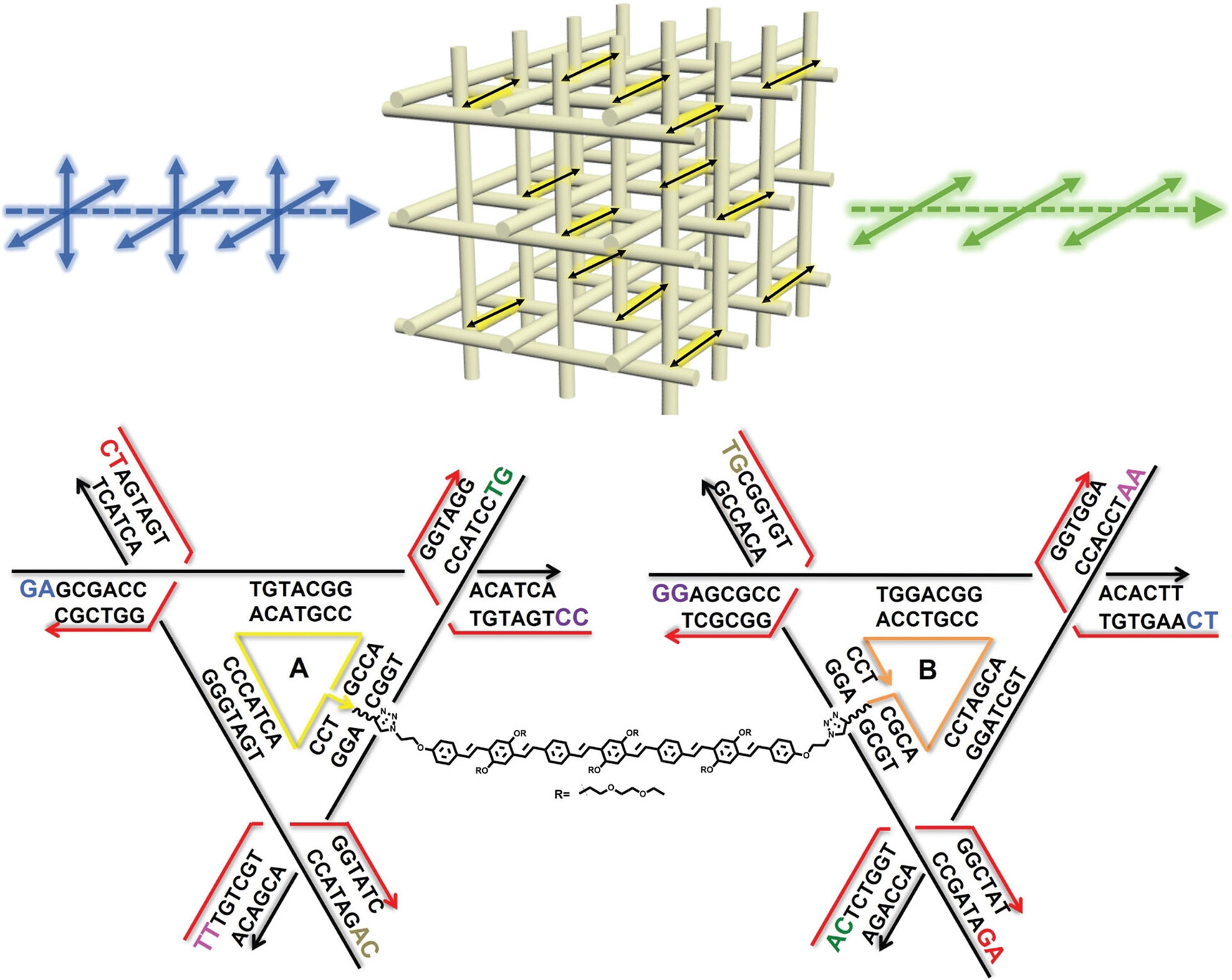
The orienting of an organic semiconductor, a heptamer of poly(p-phenylene vinylene) (HPV), into DNA 3D arrays was achieved by rational design. Addressed with covalent bonds in a DNA tensegrity triangle motif, the quasi-one-dimensional molecules were well-aligned inside the crystalline lattices, as indicated by polarized fluorescent emission. This experiment demonstrated a simple approach to constructing photonic crystals with DNA-templated band-gap materials.
CO2 Reduction | Hot Paper
Proton/Electron Donors Enhancing Electrocatalytic Activity of Supported Conjugated Microporous Polymers for CO2 Reduction
- First Published: 01 December 2021
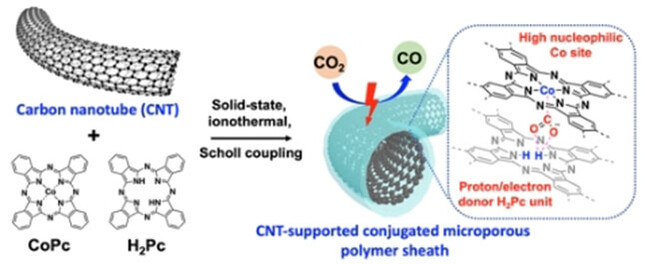
Phthalocyanines are polymerized via a solid ionothermal Scholl reaction in the presence of carbon nanotubes, resulting in an ultrathin conjugated microporous polymer sheath containing single-atom CoN4 as catalytic sites and H2Pc units as proton/electron donors, both of which interplay to enhance the electrocatalytic reduction of CO2 to CO.
Circularly Polarized Luminescence | Hot Paper
Modulating the Excited State Chirality of Dynamic Chemical Reactions in Chiral Micelles
- First Published: 08 December 2021
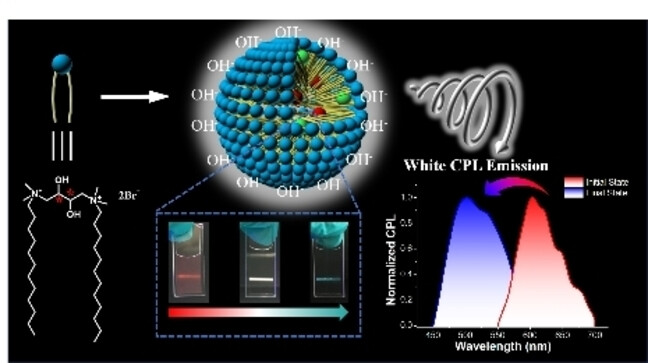
A hydrophobic cavity of chiral spherical micelles was used as the chiral space to encapsulate hydrophobic emitters and endow them with circularly polarized luminescence (CPL) properties in the aqueous phase. Particularly, through breaking the “C=N” bonds of Nile Red molecules, we have observed white CPL emission.
Transition-Metal Catalysis
Catalysis-Enabled Concise and Stereoselective Total Synthesis of the Tricyclic Prostaglandin D2 Metabolite Methyl Ester
- First Published: 06 December 2021

The clinically important tricyclic prostaglandin D2 metabolite (PGDM) methyl ester was synthesized in eight steps from a readily available known compound. The synthesis features Z-selective cross-metathesis to form the challenging Z β,γ-unsaturated ester, palladium-catalyzed carbonylative spirolactonization to build the oxaspirolactone moiety, and nickel-catalyzed Ueno–Stork-type dicarbofunctionalization to form two key C−C bonds and stereocenters.
Protein-Engineering | Hot Paper
Sortase-vermittelte Multi-Fragment-Kopplung durch Ligationsstellen-Schaltung
- First Published: 04 November 2021
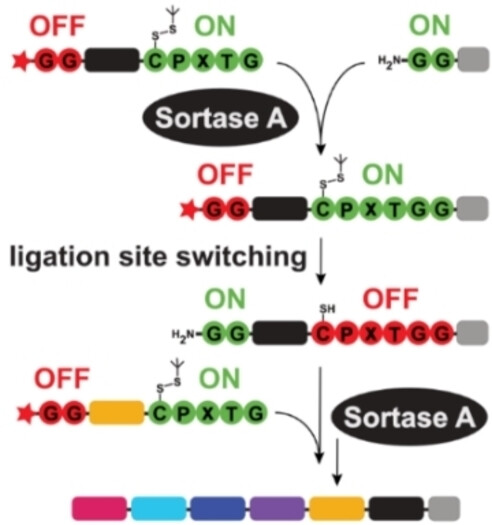
Die Sortase-vermittelte Ligation (SML) von mehreren Peptidfragmenten wird durch Umschalten der Ligationsstelle ermöglicht. Ein aktives Sortiermotiv, welches standardmäßig in das Ligationsprodukt eingebaut ist, wird von einem aktiven in einen inaktiven Zustand überführt, während ein latentes Nukleophil im Ligationsprodukt für SML aktiviert wird. Wiederholte Zyklen von SML und das Umschalten von Ligationsstellen ermöglichen die Zusammenfügung mehrerer Fragmente mit Wildtyp-Sortase.
Medizinische Chemie
Substratinspirierte Fragment-Fusion und -Erweiterung führt zu wirksamen LasB-Inhibitoren
- First Published: 11 November 2021

Eine effiziente Fragmentverschmelzungs- und -wachstumsstrategie mit einfacher Chemie führte zu einem fragmentartigen Inhibitor des Virulenzaktors LasB aus Pseudomonas aeruginosa mit einer 12-fachen Aktivitätssteigerung. Unsere optimierte Verbindung zeigt verbesserte in vivo Wirksamkeit, was die Bedeutung der Nutzung alternativer Bindungsmodi für erfolgreiche Fragmentverschmelzung hervorhebt. Die Abbildung wurde mit dem Programm BioRender (www.biorender.com) kreiert.
Oberflächenchemie
Einsatz der kooperativen Katalyse für die Oberflächensynthese linearer heteroaromatischer Polymere durch selektive C-H-Aktivierung
- First Published: 17 November 2021
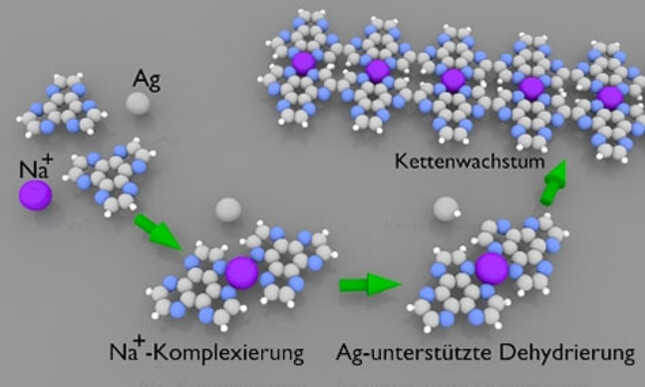
Die kooperative katalytische Rolle von Natrium- und Silberatomen bei der Steuerung der Oberflächenpolymerisation von Hexaazatriphenylenmolekülen auf Ag(111) wird demonstriert. Durch die Kombination von hochauflösender Rastersondenmikroskopie mit Dichtefunktionaltheorie-Berechnungen wird aufgeklärt, wie komplexe Oberflächenprozesse durch das Hinzufügen atomarer Spezies, die für die Katalyse spezifischer Reaktionsschritte verantwortlich sind, ermöglicht werden können.
Forschungsartikel
Supramolecular Catalysis | Hot Paper
Creating Dynamic Nanospaces in Solution by Cationic Cages as Multirole Catalytic Platform for Unconventional C(sp)−H Activation Beyond Enzyme Mimics
- First Published: 15 November 2021
Peptides | Hot Paper
Binding of Natural Peptide Ligands to the Neuropeptide Y5 Receptor
- First Published: 25 November 2021

Complementary biochemical methods and molecular modeling reveal how NPY and its natural analogues bind to the Y5 GPCR, filling in the gap in the knowledge of the Y multiligand/multireceptor system. This provides the first base for the rational design of selective Y5R ligands with therapeutic potential.
Photodynamic Inactivation
Design of a Metallacycle-Based Supramolecular Photosensitizer for In Vivo Image-Guided Photodynamic Inactivation of Bacteria
- First Published: 21 November 2021
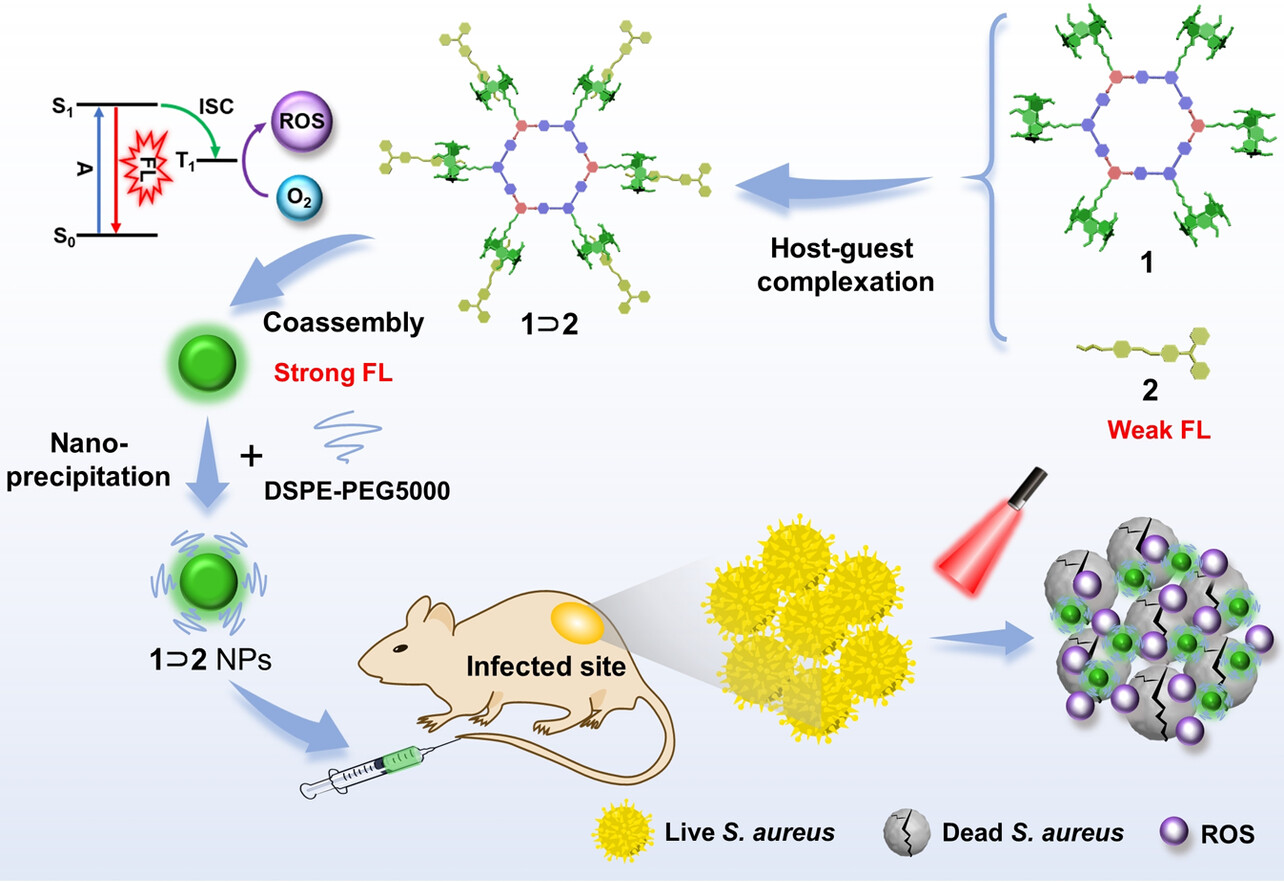
A metallacycle-based supramolecular photosensitizer (1⊃2) for in vivo image-guided photodynamic inactivation of bacteria is reported. Through host-guest interaction, the assembly 1⊃2, with improved fluorescence signals and ROS production capabilities, is employed for in vivo fluorescence tracking as well as accurate image-guided treatment of S. aureus infection without noticable side effects.
Photocatalysis
Photophysics of Perylene Diimide Dianions and Their Application in Photoredox Catalysis
- First Published: 17 November 2021
Artificial Metalloenzymes
Directed Evolution of Artificial Metalloenzymes in Whole Cells
- First Published: 11 November 2021
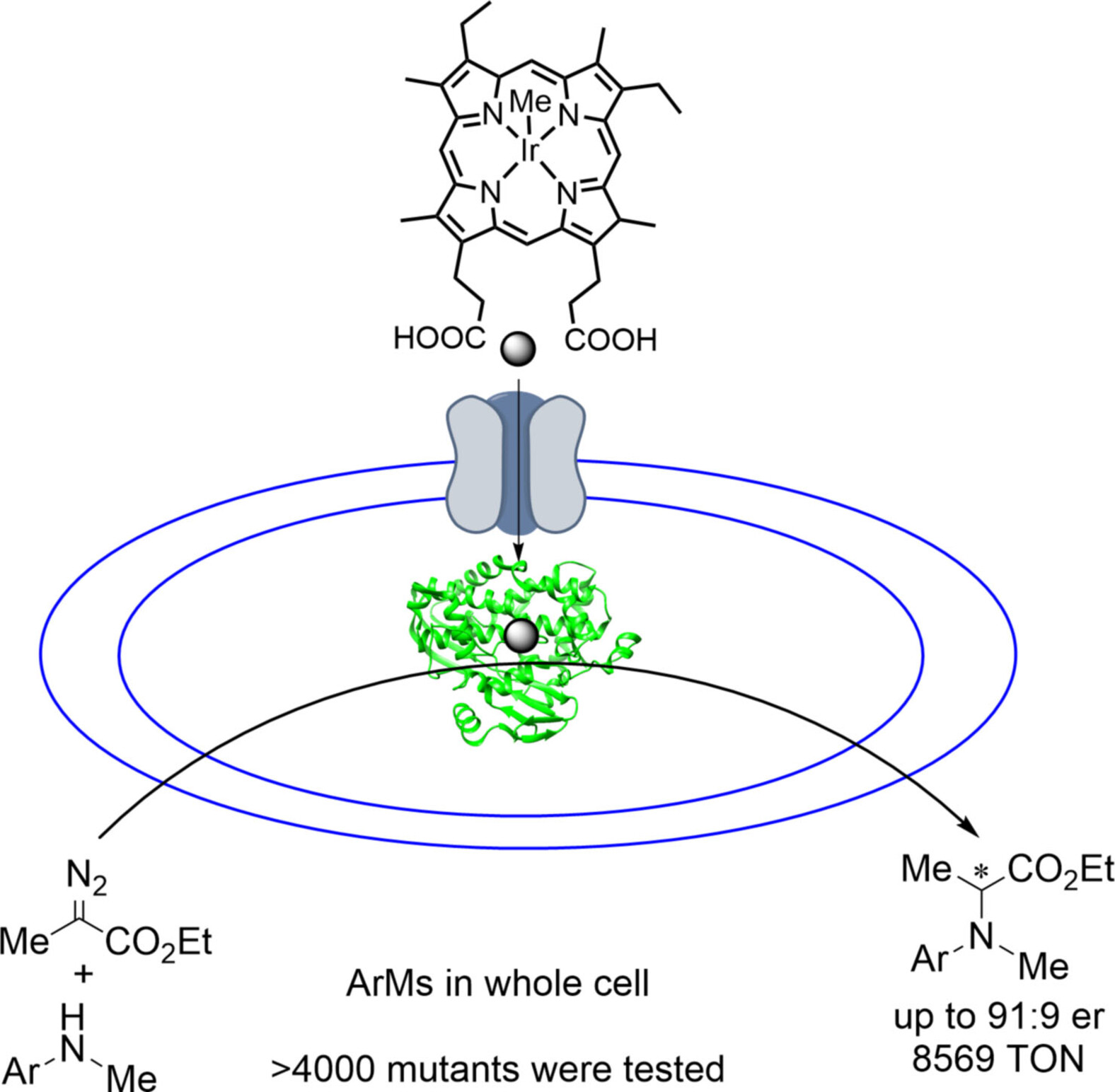
Whole-cell E. coli platform enables directed evolution campaigns with ArMs containing an abiotic Ir-porphyrin cofactor involving the generation of more than 4000 mutants to develop an enantioselective insertion of a simple acyclic carbene from a diazo ester into the N−H bond of N-methyl aniline that has formed product with poor enantioselectivity when catalyzed by prior enzyme systems.
Zeolites | Hot Paper
Enhanced Reactivity of Accessible Protons in Sodalite Cages of Faujasite Zeolite
- First Published: 12 November 2021
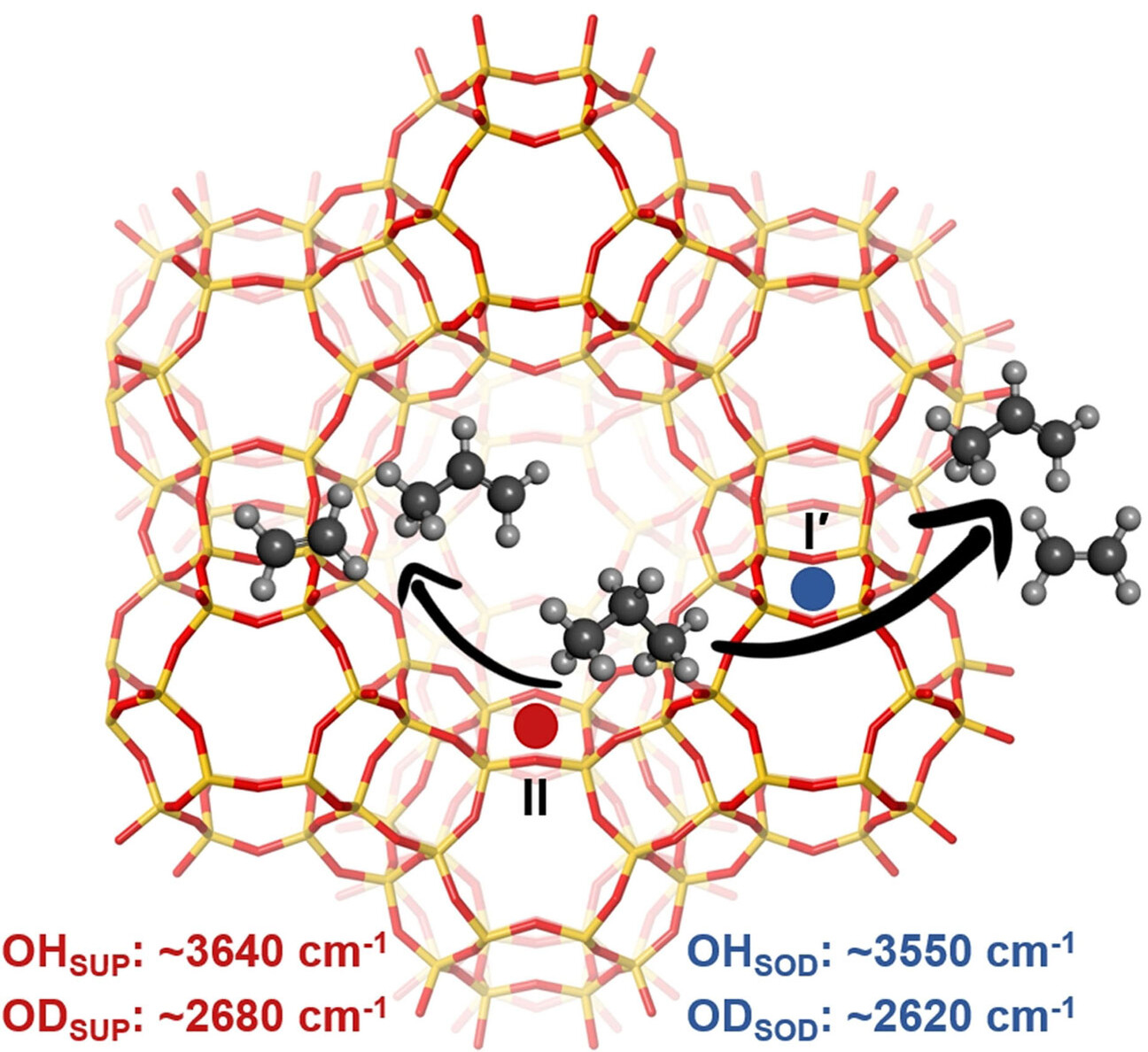
Faujasite (FAU) zeolites (with Si/Al ratio of ca. 1.7) undergo mild dealumination at moderate ion exchange conditions (0.01 to 0.6 M of NH4NO3 solutions) resulting in protons circumscribed by sodalite cages becoming accessible for reaction. The ratio of protons in sodalite cages (HSOD) to supercages (HSUP) can be manipulated by adjusting ammonium concentrations used in ion exchange.
Peptides
Site-Selective Itaconation of Complex Peptides by Photoredox Catalysis
- First Published: 29 November 2021

Photoredox catalysis has emerged as a powerful approach for site-selective peptide functionalization. Herein, we report a highly N-termini-specific method to rapidly access itaconated peptide derivatives under mild photoredox conditions. Distinct from conventional methods that rely on residue nucleophilicity, this method proceeds through a highly reactive carbamoyl radical intermediate to achieve excellent selectivity. Itaconated peptides can be further functionalized to access peptide-protein conjugates.
Synthetic Methods | Hot Paper
Trifluoroethanol as a Unique Additive for the Chemoselective Electrooxidation of Enamines to Access Unsymmetrically Substituted NH-Pyrroles
- First Published: 01 December 2021

A chemoselective electrooxidative heterocoupling of two different enamines is reported for the synthesis of unsymmetrically substituted NH-pyrroles. A „magic effect“ of the additive trifluoroethanol is utilized to achieve the desired chemoselectivity by tuning the oxidation potentials and controlling the activation energy of the rate-determining step.
Transition Metal Complexes | Hot Paper
Bimetallic Copper/Ruthenium/Osmium Complexes: Observation of Conformational Differences Between the Solution Phase and Solid State by Atomic Pair Distribution Function Analysis
- First Published: 17 November 2021
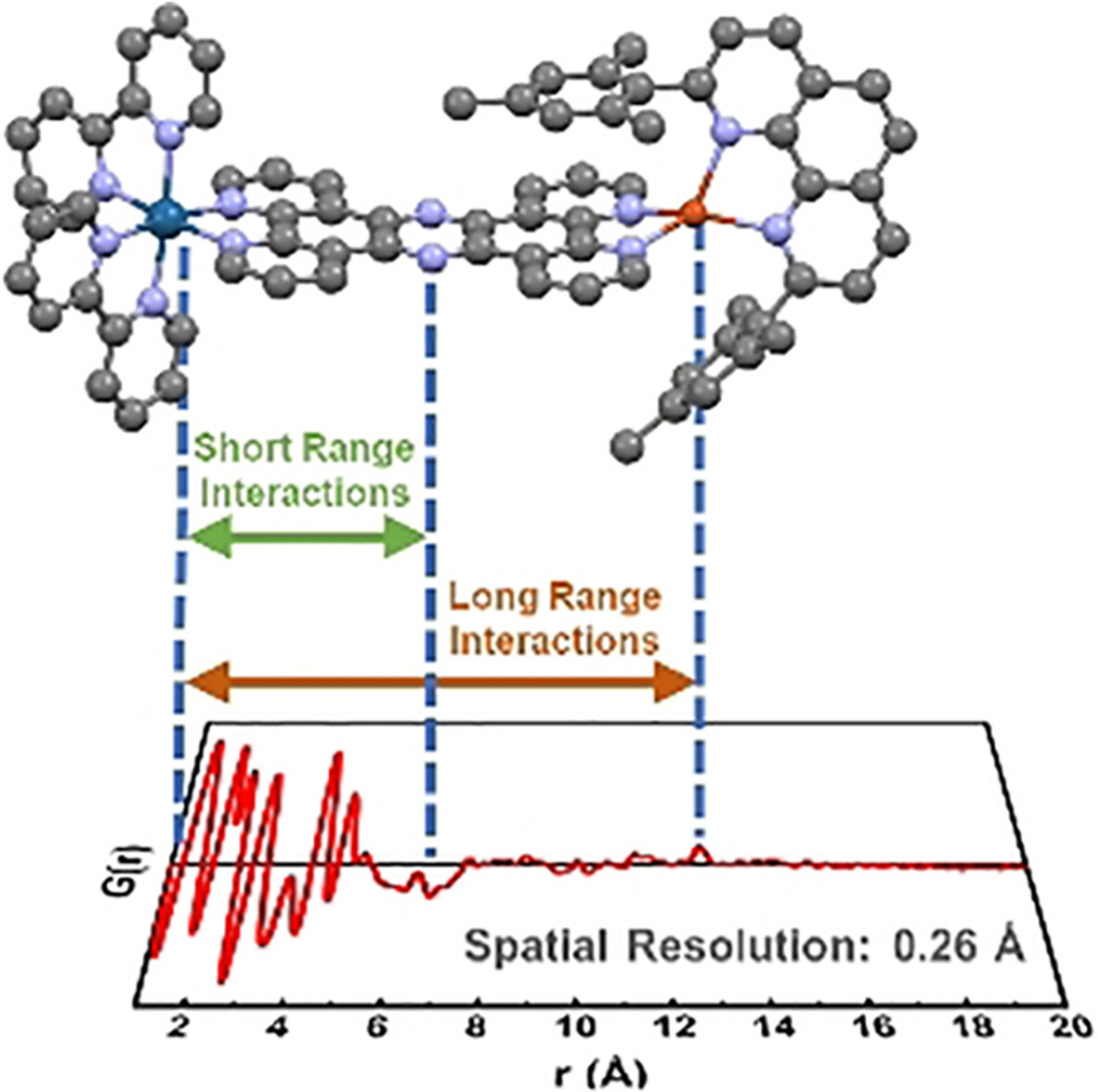
The solution phase structure of five bimetallic CuI/RuII/OsII complexes was revealed by high-energy X-ray scattering and pair distribution function analysis (HEXS/PDF). Assisted by computational simulation, conformational differences of the complexes in the solution and solid states were identified with sub-Ångström resolution.
Bioconjugation
Tunable Amine-Reactive Electrophiles for Selective Profiling of Lysine
- First Published: 11 November 2021

Tunable and hydrolytically stable electrophiles are reported for the chemo-selective labeling of lysine with mass sensitive probes. These tunable amine-reactive electrophiles (TAREs) were used to label proteins in various subcellular compartments inside cells and for global identification of lysine in the human proteome.
Isotope Labelling | Hot Paper
Stable Isotope Phosphate Labelling of Diverse Metabolites is Enabled by a Family of 18O-Phosphoramidites
- First Published: 03 November 2021

A family of 18O2-phosphoramidites facilitates synthetic access on gram-scale to various isotopically pure 18O-labelled phosphate products, like nucleotides, inositol phosphates, polyphosphates, and DNA. The utility of these 18O-natural products is underlined in the assignment of various metabolites from biological matrices using capillary electrophoresis electrospray ionisation triple quadrupole mass spectrometry.
Natural Products
A Modular Approach to the Antifungal Sphingofungin Family: Concise Total Synthesis of Sphingofungin A and C
- First Published: 22 October 2021
Photochemistry | Hot Paper
Generation of Oxyphosphonium Ions by Photoredox/Cobaloxime Catalysis for Scalable Amide and Peptide Synthesis in Batch and Continuous-Flow
- First Published: 15 November 2021

A photocatalytic method for the synthesis of amides and peptides is reported. Synergistic cooperation between a cobaloxime and a photoredox catalyst removes the elements of H2O through the use of PPh3 as a gentle organic reductant. The deoxygenative method is compatible with gram-scale peptide synthesis and applicable to peptide fragment condensation and SPPS, which may find applications in both organic synthesis and pharmaceutical production.
Capacitance
Unexpectedly High Capacitance of the Metal Nanoparticle/Water Interface: Molecular-Level Insights into the Electrical Double Layer
- First Published: 18 November 2021
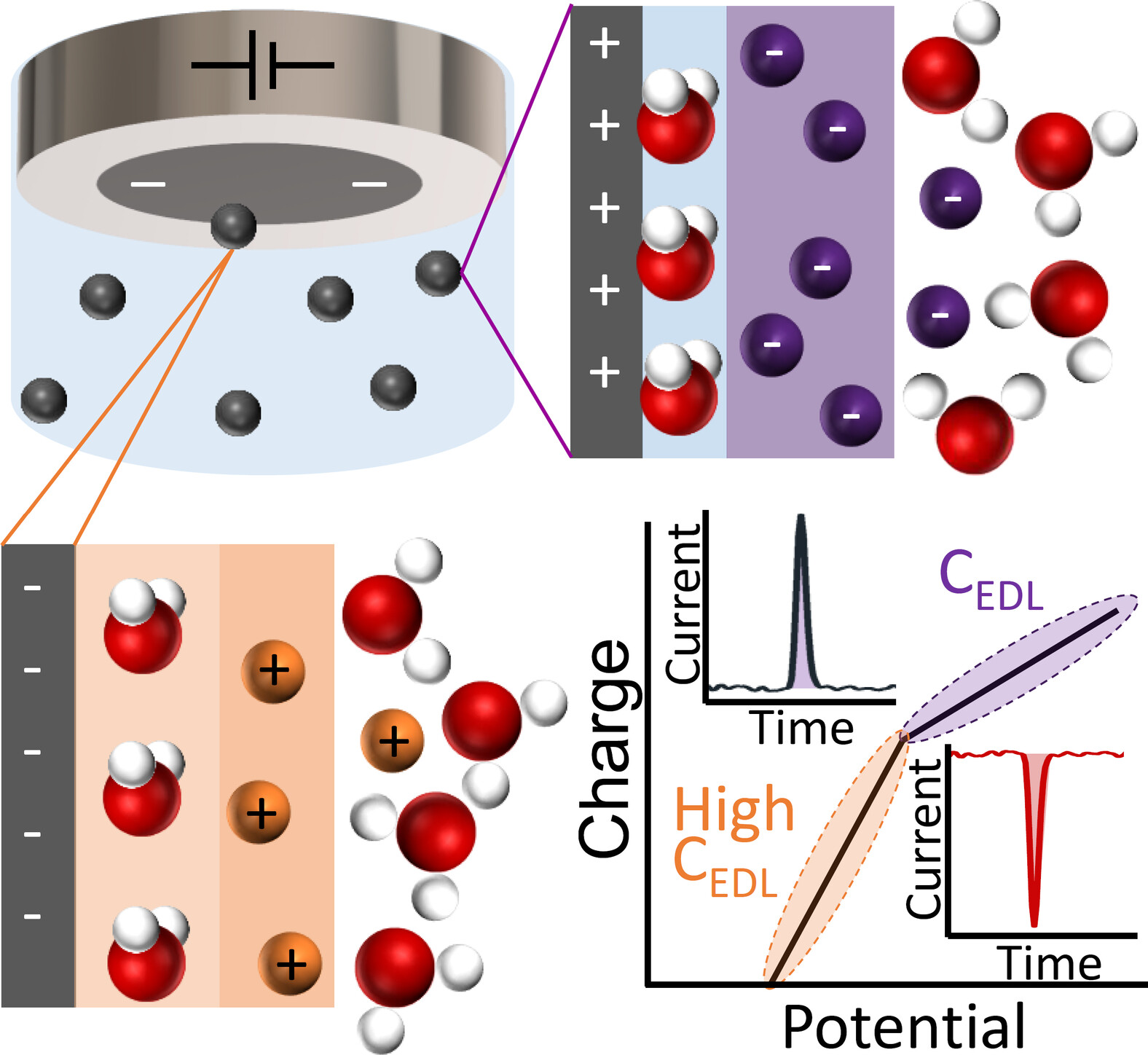
Nano-impact electrochemistry revealed an anomalously high capacitance for Pt nanoparticles and to a lower extent for Au nanoparticles at potentials more negative than their potential of zero charge. MD calculations showed that the strong interaction of metal with water molecules leads to water chemisorption and accumulation of ions in the Helmholtz layer beyond expectation, resulting in a higher interface charge storage ability.
Hot Electrons
In Situ Raman Probing of Hot-Electron Transfer at Gold–Graphene Interfaces with Atomic Layer Accuracy
- First Published: 22 November 2021
Polyoxometalate Electrocatalysts
Molecular Transition Metal Oxide Electrocatalysts for the Reversible Carbon Dioxide–Carbon Monoxide Transformation
- First Published: 29 November 2021

A modular synthesis of trimetallo-substituted polyanions enables the preparation of designer catalysts. Here this approach was used to prepare electrocatalysts for the selective reduction of CO2 to CO using a tri-copper-substituted polyanion. In contrast, Fe–Ni-substituted polyanions preferably catalyzed the oxidation of CO to CO2, showing a reactivity profile reminiscent of the reactivity of Fe–Ni-based carbon monoxide dehydrogenase enzymes.
Zeolites | Hot Paper
Zinc Containing Small-Pore Zeolites for Capture of Low Concentration Carbon Dioxide
- First Published: 19 November 2021
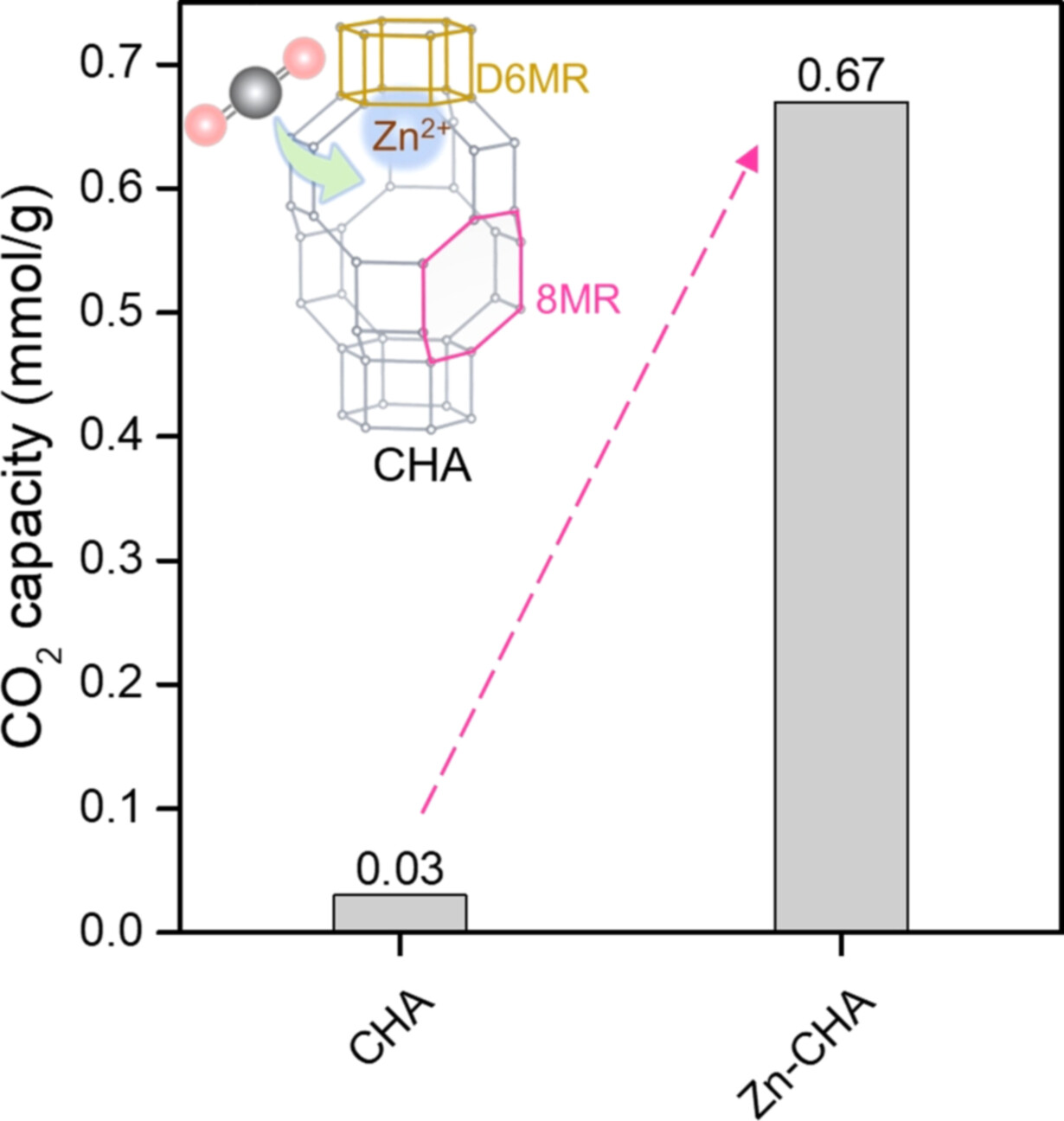
Low concentration CO2 is adsorbed in zinc containing CHA-type zeolites with a high capacity of 0.67 mmol CO2/g-zeolite. The materials exhibit higher CO2 capacity, faster kinetics, lower desorption energy than low-silica 13X zeolites. Zeolite framework and the states and locations of zinc ions play crucial roles in the adsorption performance.
Medical Imaging
A Bivalent Activatable Fluorescent Probe for Screening and Intravital Imaging of Chemotherapy-Induced Cancer Cell Death
- First Published: 11 November 2021
Lewis Pairs
Linear Extension of Anthracene via B←N Lewis Pair Formation: Effects on Optoelectronic Properties and Singlet O2 Sensitization
- First Published: 30 November 2021
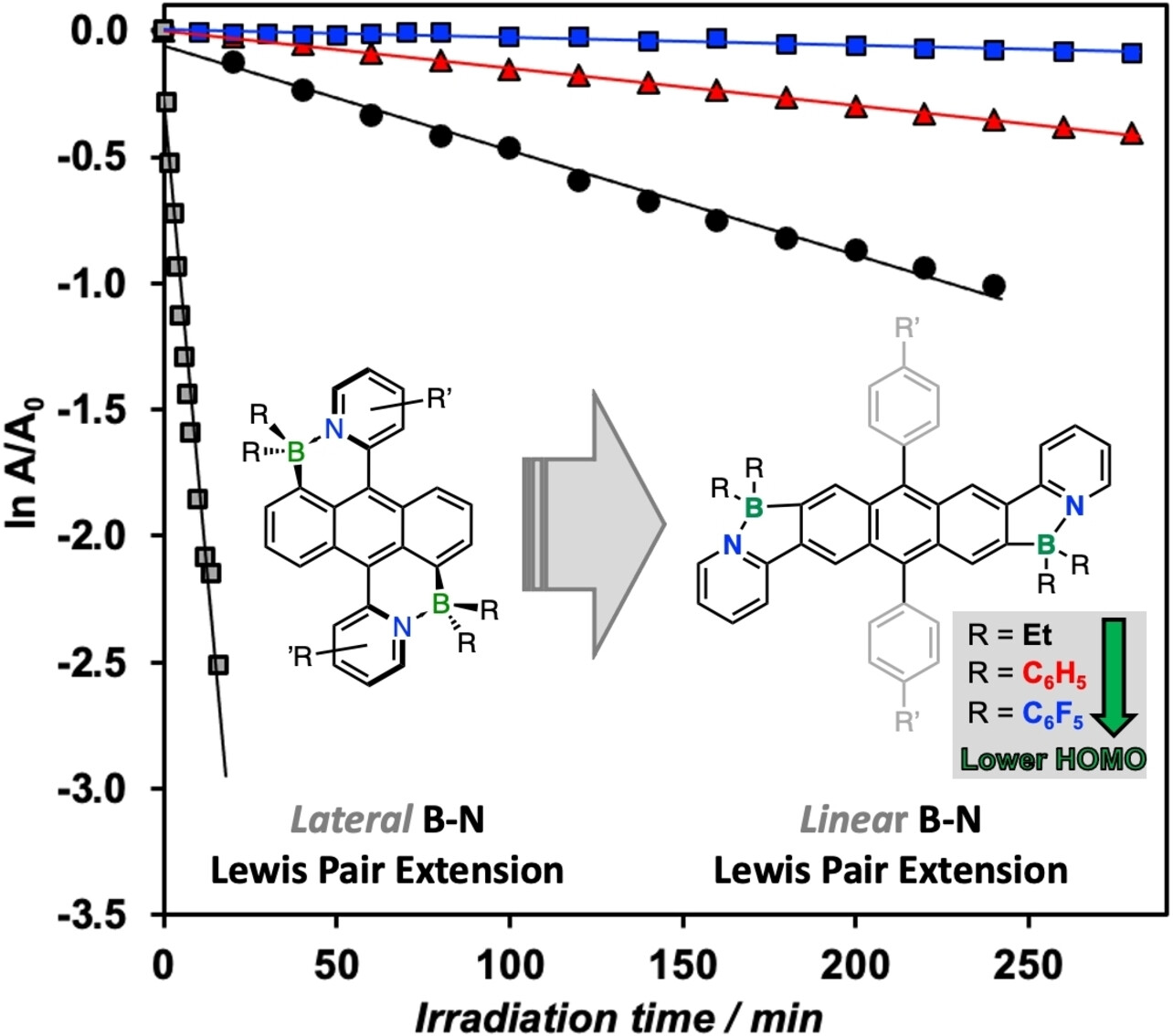
Linearly B←N Lewis pair extended anthracenes are prepared by highly regioselective N-directed electrophilic borylation. Their LUMOs are higher in energy and their HOMO–LUMO gaps are significantly larger compared to those of the respective laterally functionalized species. Photooxygenation studies reveal effective singlet oxygen sensitization with a largely reduced tendency for self-sensitized endoperoxide formation.
Perovskite Solar Cells
Green-Chemistry-Inspired Synthesis of Cyclobutane-Based Hole-Selective Materials for Highly Efficient Perovskite Solar Cells and Modules
- First Published: 16 December 2021
Host–Guest Chemistry
A Conjugated Figure-of-Eight Oligoparaphenylene Nanohoop with Adaptive Cavities Derived from Cyclooctatetrathiophene Core
- First Published: 24 November 2021
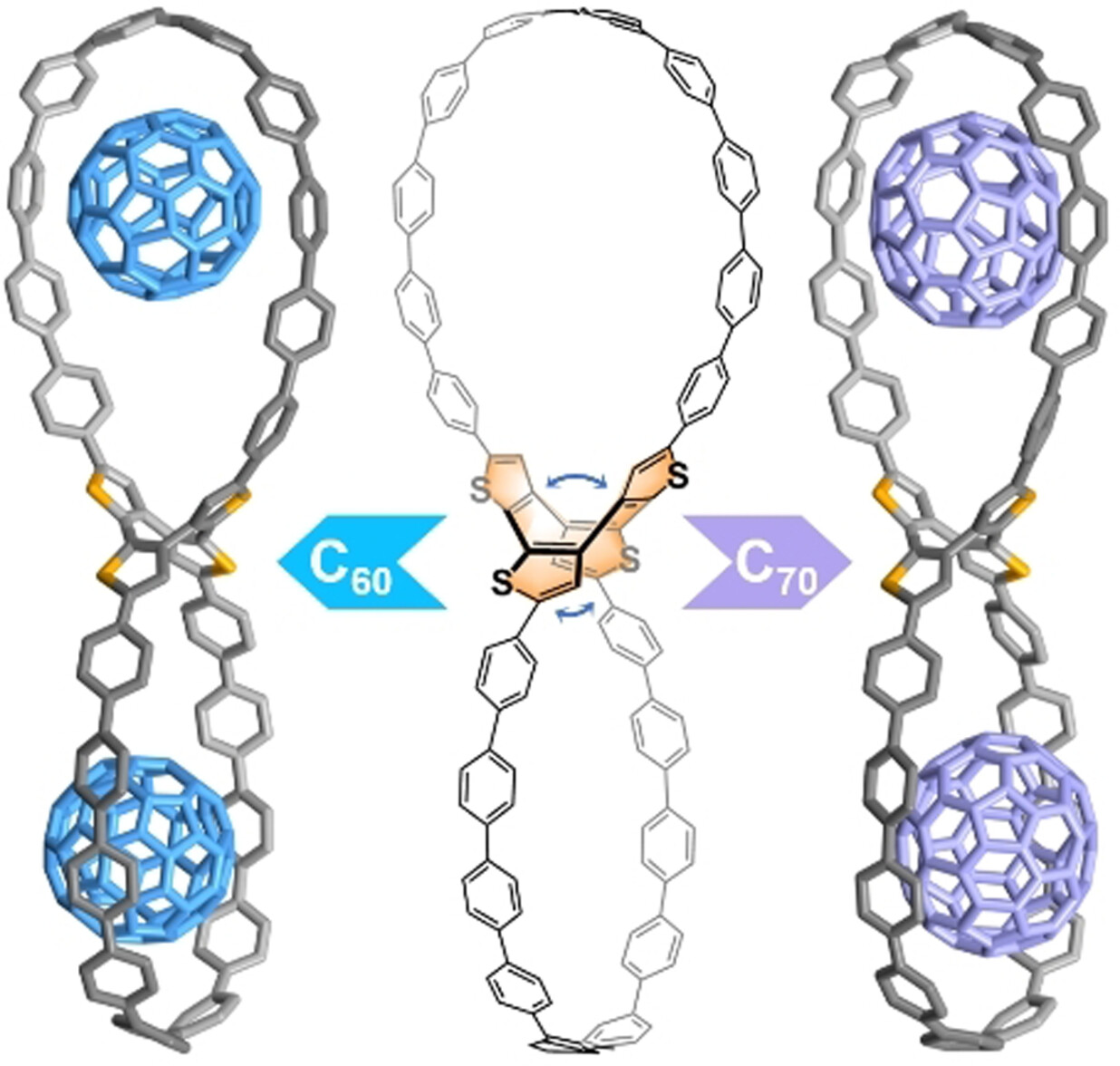
Based on strained oligoparaphenylene loops and a flexible cyclooctatetrathiophene moiety, a fully conjugated bis-macrocycle is efficiently constructed, and possesses rigid and guest-adaptive cavities. Its peanut-like 1:2 host–guest complexes with C60 or C70 have been isolated and characterized, respectively.
Nanostructures
Control over Multiple Nano- and Secondary Structures in Peptide Self-Assembly
- First Published: 10 November 2021
On-Surface Synthesis | Hot Paper
Abiotic Formation of an Amide Bond via Surface-Supported Direct Carboxyl–Amine Coupling
- First Published: 28 October 2021
Hydrogenation | Very Important Paper
Local Environment Determined Reactant Adsorption Configuration for Enhanced Electrocatalytic Acetone Hydrogenation to Propane
- First Published: 25 November 2021

For acetone to propane electrohydrogenation, we unveiled how the local environmental pH determines the adsorption configuration of acetone, and further, the efficiency of the catalytic process. Moreover, it is showed that the reaction efficiency of the reaction can be improved by simply adjusting local pH instead of complex catalyst engineering.
Supramolecular Polymers
Biasing the Hierarchy Motifs of Nanotoroids: from 1D Nanotubes to 2D Porous Networks
- First Published: 25 November 2021
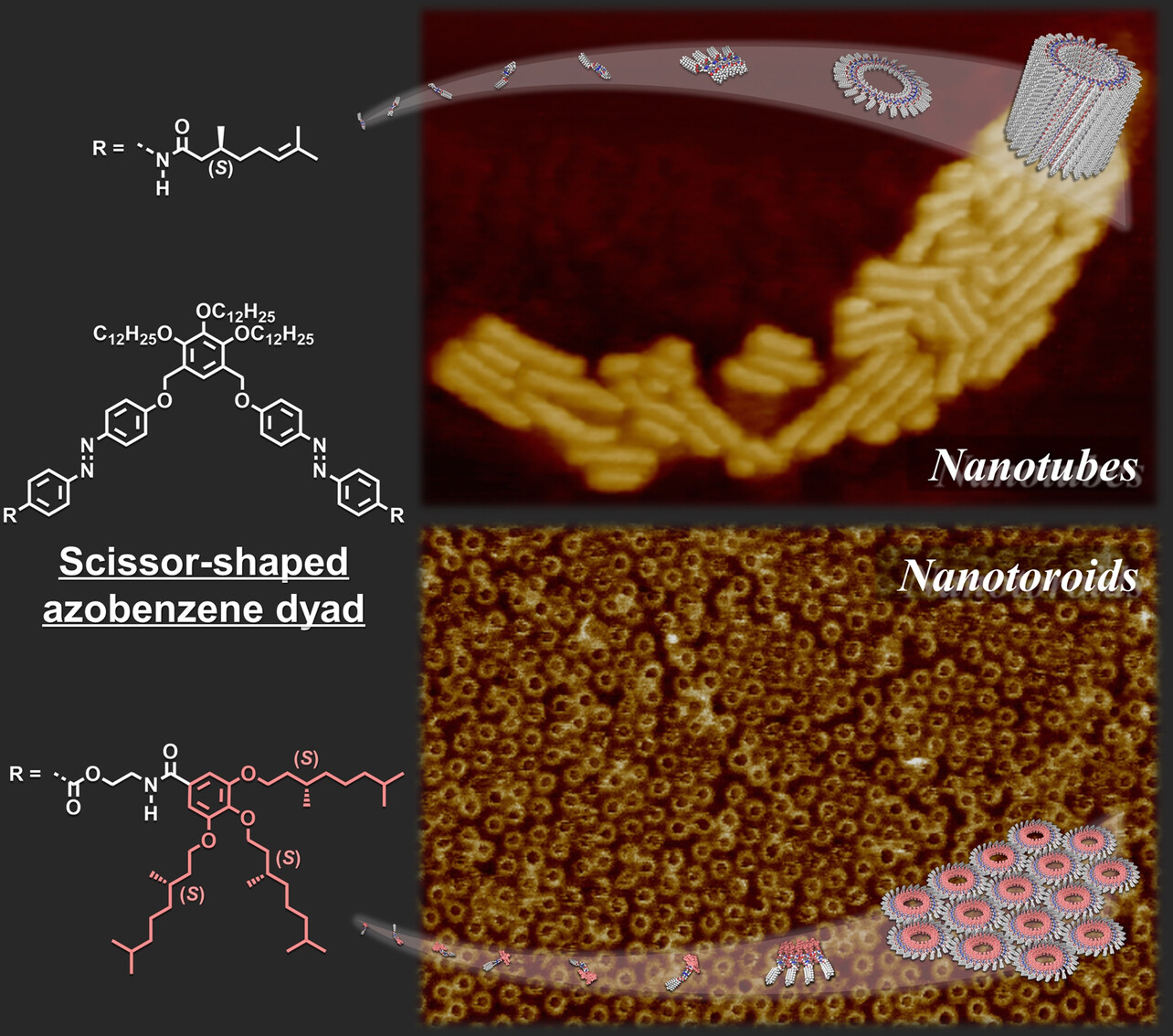
The steric demand exerted by the peripheral side chains of the reported azobenzene dyads impedes their hierarchical self-assembly from nanotoroids into nanotubes. In contrast, they organize into 2D porous networks on substrate upon solution processing. Photoisomerization of azobenzene moieties allows efficient dissociation/reorganization of nanotoroids in solution, demonstrating their potential as photoresponsive 2D porous nanosheets.
Solar Cells | Hot Paper
Diammonium Molecular Configuration-Induced Regulation of Crystal Orientation and Carrier Dynamics for Highly Efficient and Stable 2D/3D Perovskite Solar Cells
- First Published: 23 November 2021
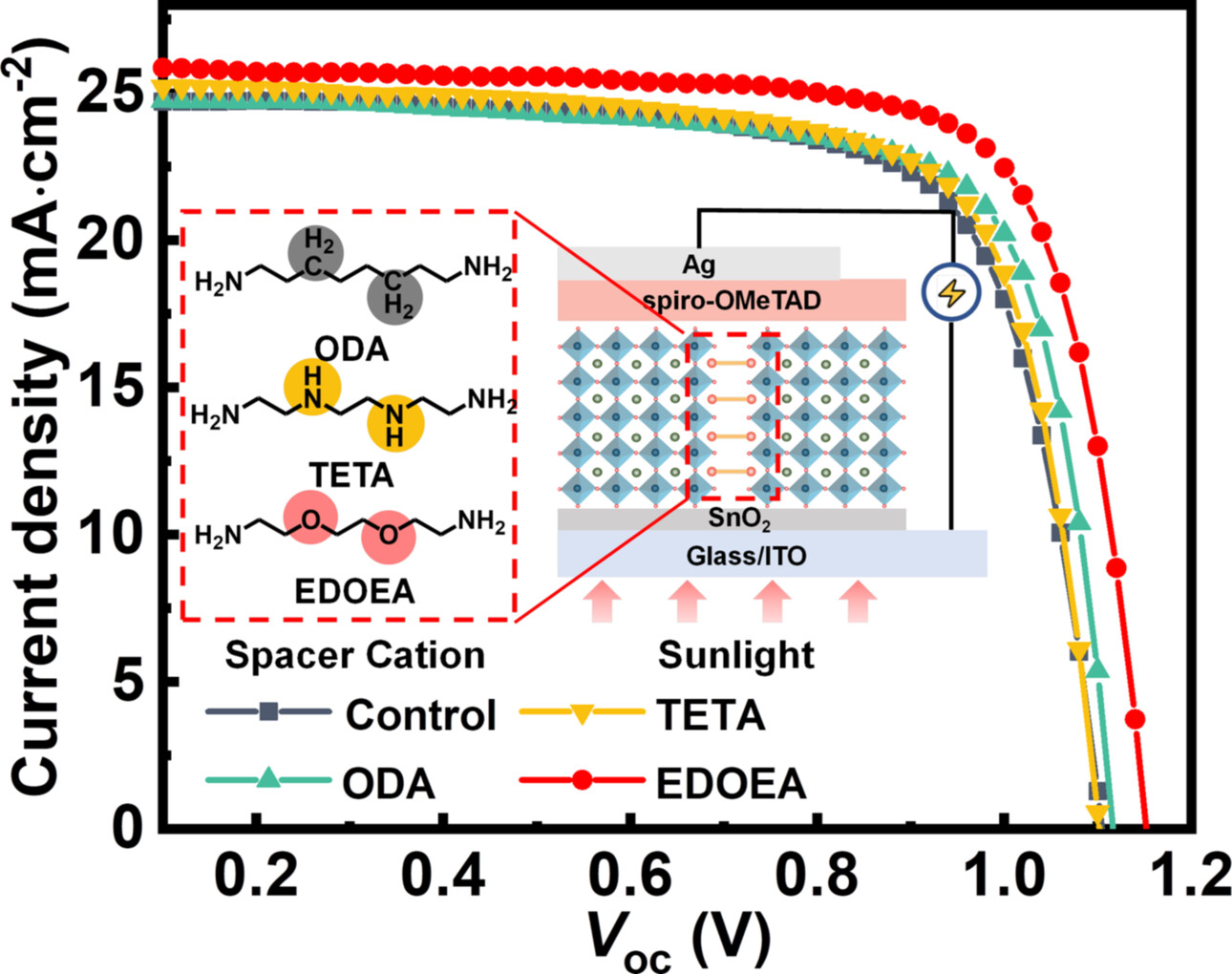
Various diammonium spacer cations are used to construct 2D/3D perovskite. The mechanism of molecular configuration-induced regulation of crystal orientation and carrier dynamics is investigated. 2D/3D perovskite solar cells based on 2,2′-(ethylenedioxy)bis(ethylamine) achieve device efficiency of 22.68 % and excellent moisture stability, retaining 82 % of initial efficiency after aging at 50±5 % relative humidity for 1560 h.
CO2 Reduction | Hot Paper
Imparting CO2 Electroreduction Auxiliary for Integrated Morphology Tuning and Performance Boosting in a Porphyrin-based Covalent Organic Framework
- First Published: 21 November 2021
Hemilabile Ligands | Hot Paper
Controlling Oxidative Addition and Reductive Elimination at Tin(I) via Hemi-Lability
- First Published: 22 November 2021

A distannyne supported by a pincer ligand featuring pendant CH2NiPr2 arms is capable of reversibly activating E−H bonds at one or both of the tin centres through dissociation of the hemi-labile N–Sn donor/acceptor interactions. This chemistry can be exploited to sequentially (and reversibly) assemble mixed-valence chains of tin atoms of the type ArSn{Sn(Ar)H}nSnAr (n=1,2).
Polymerization | Very Important Paper
From Impossible to Possible: Atom-Economic Polymerization of Low Strain Five-Membered Carbonates
- First Published: 01 December 2021
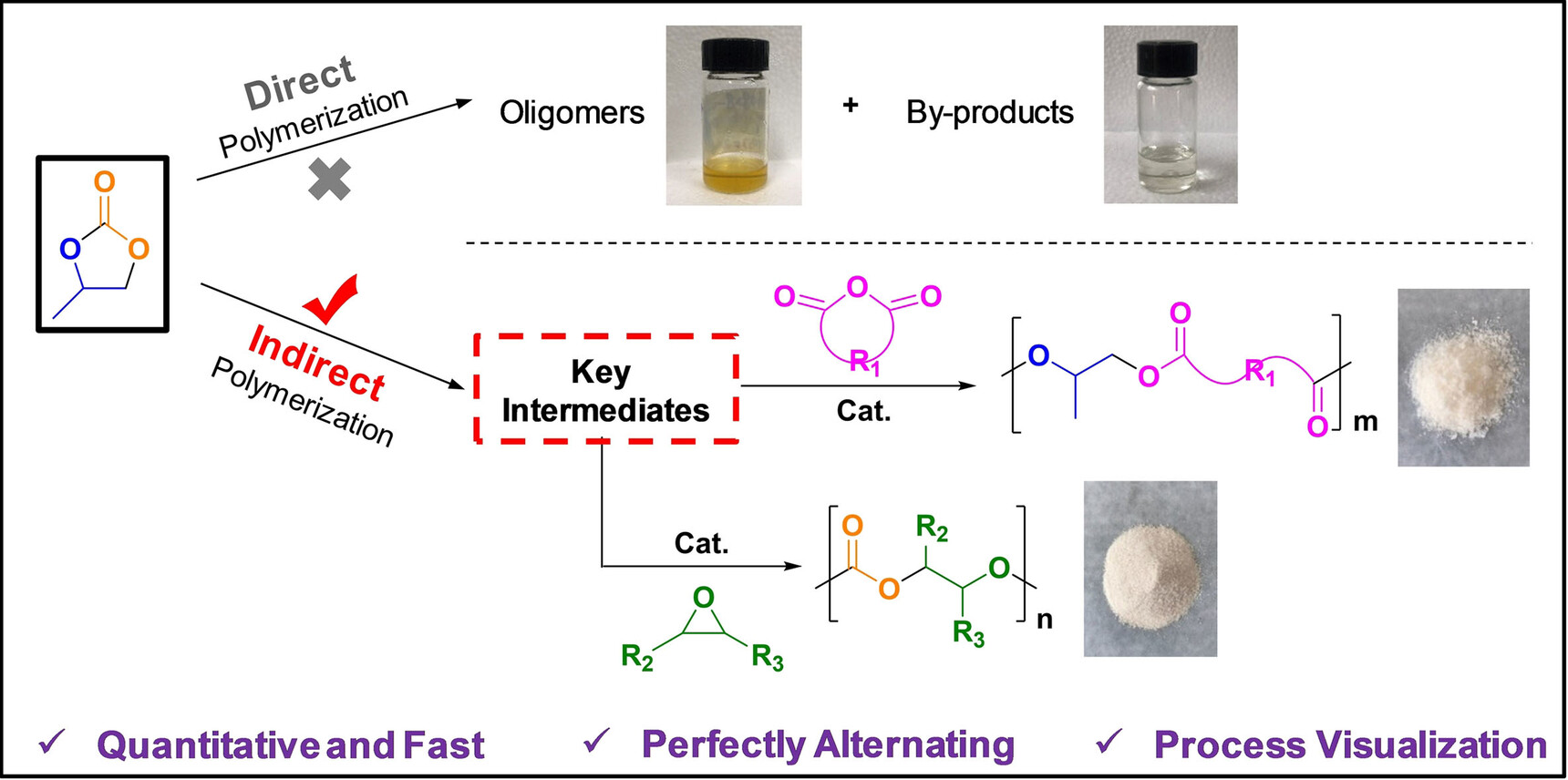
An atom-economic polymerization of five-membered propylene carbonate (PC) for preparation of polyester and polycarbonate simultaneously is reported. The key premise of our strategy is the careful elaboration of the mechanism of direct ring-opening polymerization of PC, which emphasizes the importance of the in situ released propylene oxide.
Block Copolymers | Hot Paper
Janus Photonic Microspheres with Bridged Lamellar Structures via Droplet-Confined Block Copolymer Co-Assembly
- First Published: 02 December 2021
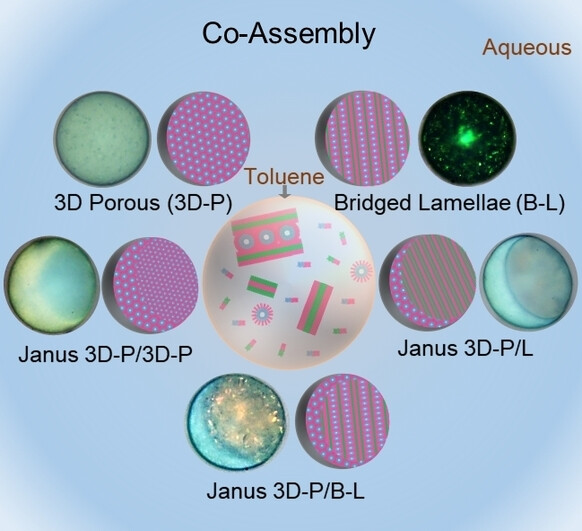
A new complex photonic structure, bridged lamellae, with intriguing color reflections is successfully fabricated through well-controlled co-assembly of lipophilic and amphiphilic bottlebrush block copolymers within shrinking droplets. Self-assembled Janus microspheres with precisely tunable dual light reflections are facilely obtained through the manipulation of the co-assembly at a molecular level.
Polymer Calibration
Solvent-Independent Molecular Weight Determination of Polymers Based on a Truly Universal Calibration
- First Published: 03 December 2021
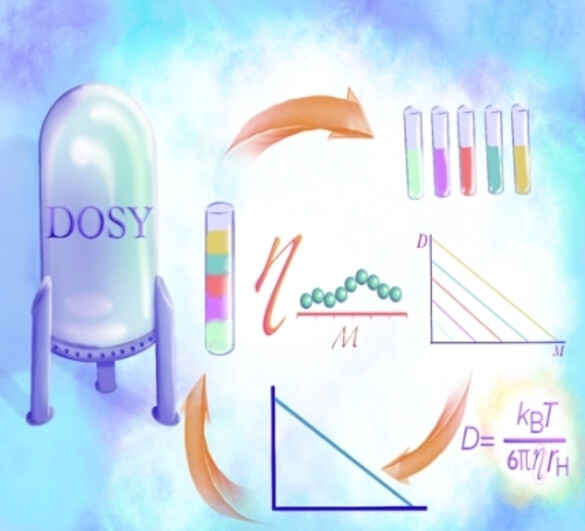
A universal calibration curve for molecular weight determination is presented. Diffusion coefficients of poly(styrene) and poly(ethylene glycol) standards are measured via diffusion-ordered NMR spectroscopy. These diffusion/molecular weight relationships are calibrated to be solvent-independent. This universal calibration creates a novel platform wherein molecular weights of unknown polymers can be found using the universal calibration curve independent of what solvent is used.
Covalent Organic Frameworks
A Nanographene-Based Two-Dimensional Covalent Organic Framework as a Stable and Efficient Photocatalyst
- First Published: 06 December 2021

Dibenzo[hi,st]ovalene-based covalent organic frameworks form 2D ABC stacking sp2 carbon lattices with robust olefin linkage. The resulting 2D unique structure exhibits high photoconductivity, charge-carrier mobility and photocatalytic activity in hydroxylation attributed to the narrow-energy-gap nanographene cores as active sites.
Synthesemethoden
Dynamische kinetische Sensibilisierung von β-Dicarbonyl-verbindungen – Zugang zu mittelgroßen Ringen durch eine De-Mayo-artige Ringerweiterung
- First Published: 24 November 2021

In dieser Arbeit wird eine photokatalysierte Ringerweiterung für eine C2-Homologisierung von cyclischen Carbonylverbindungen zu mittelgroßen Ringsystemen vorgestellt. Diese gelingt mit Hilfe des Katalysators fac-[Ir(CF3-pmb)3] (ET=73.3 kcal mol−1), der eine selektive Aktivierung der substöchiometrischen Enolspezies ermöglicht. Der Mechanismus wurde durch zeitaufgelöste Spektroskopie untersucht und ermöglicht eine vollständige kinetische Analyse des dynamischen kinetischen Sensibilisierungsszenarios.
Aktivierung kleiner Moleküle | Hot Paper
Synthese und Reaktivität eines Neutralen Homozyklischen Silylens
- First Published: 19 November 2021

Das neutrale homozyklische Silylen 2 wurde ausgehend vom bizyklischen Silicium(I)-Amid J erhalten. Diese Reaktion verläuft über die anionische homoaromatische Ringverbindung 1. Das zweifach-koordinierte Si-Atom in 1 wird durch eine 3-Zentren-2-Elektronen-π-Bindung stabilisiert und das in 2 durch eine allyl-artige π-Elektronendelokalisation. Silylen 2 geht Cycloadditionen mit Alkenen und Alkinen und eine oxidative Addition mit Methanol ein. Die Reaktion mit Ethen führt zu einer trizyklischen Ringspezies.




